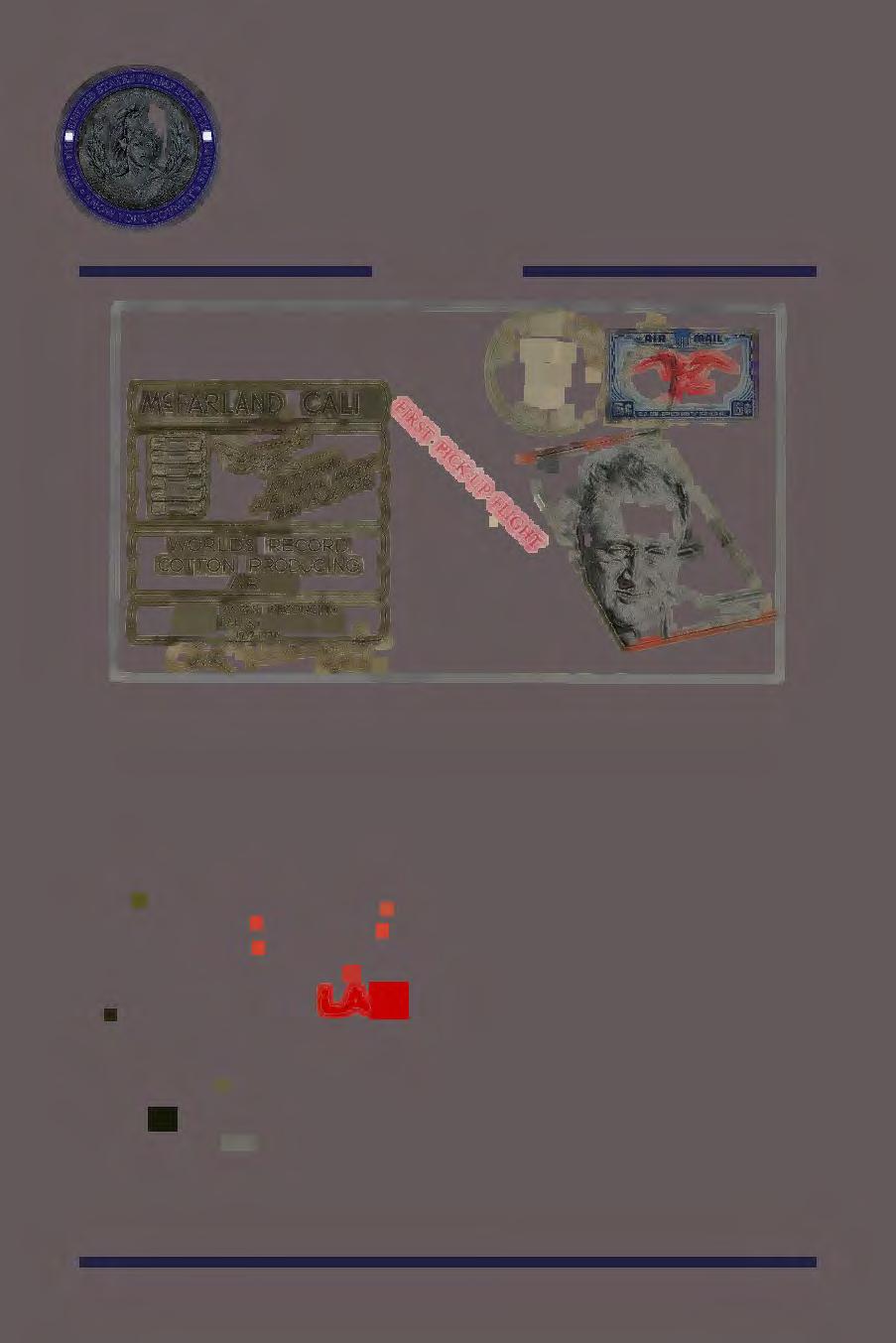
The United States SPECIALIST VOLUME 95, NUMBER 4 APRIL 2024 WHOLE NUMBER 1130 for the Collector of Postage & Revenue Stamp Issues of the United States s plus e Plate Varieties on the Poland Overrun Countries Stamp c and j Rutland Railroad “Emergency” Handstamp, New Retouched on Cheek Variety on Scott 528B, & more 1938 Bi-Color Airmail Stamp: FDR, Farley and National Air Mail Week, Part II .,,_ • fflAI 2 PM , • 19:Je / [iE _

United States Stamp Society Publications Order from: USSS, P.O. Box 1602, Hockessin, DE 19707-5602 or online at: www.usstamps.org/store/ Hardbound, 769 pages. $35 members, $40 nonmembers. Visit the website for shipping costs. Softbound, 253 pages. Postpaid: $25 members, $28 nonmembers. Visit the website for shipping costs. Encyclopedia of United States Stamps and Stamp Collecting Second Edition Edited by Rodney A. Juell, Lynn R. Batdorf and Steven J. Rod United States Savings Stamps by Harry K. Charles, Jr. A presentation of the United States Postal and Treasury Savings Stamp Systems, the stamps and their closely associated collection cards and booklets, and Official Mail stamps and stationery. United States Savings Stamps

An association of collectors to promote the study of all postage and revenue stamps and
Andrew S. Kelley, Editor 9038 East 25th Drive Denver, CO 80238 (720) 839-5848 email: editor@usstamps.org www.usstamps.org Manuscripts, publications for review, and all advertising including classifieds, should be sent to the editor at the address above. Forms close on the 20th of the second month preceding the month of publication, as February 20 for the April edition. The United States Specialist (ISSN 0164-923X) is published monthly January through December by the United States Stamp Society, Inc., P.O. Box 1602, Hockessin, DE 19707-5602. Membership in the United States $25. North America $40; all others $65. Single copy $2. Periodical postage paid at Hockessin, DE, and at additional entry offices. Printed in USA. Copyright ©2024 United States Stamp Society, Inc. All rights reserved. Opinions expressed by authors are their own and do not necessarily reflect those of the United States Stamp Society, its officers, or staff. Correspondence concerning business affairs of the Society, including membership and changes in address, should be addressed to the Executive Secretary, PO Box 1602, Hockessin, DE 19707-5602. Postmaster: Send address changes to U.S.S.S., P.O. Box 1602, Hockessin, DE 19707-5602.
stamped paper of the United States and US-administered areas produced by the Bureau of Engraving and Printing and other contract printers. American Philatelic Society Affiliate No. 150 The United States SPECIALIST the journal of the United States Stamp Society VOLUME 95, NUMBER 4 APRIL 2024 WHO LE NUMBER 1130 Features 153 Plate Varieties on the Poland Overrun Countries Stamp by Keith Lichtman 158 Rutland Railroad “Emergency” Handstamp by R oger S. Brody 160 A New Type of the Retouched on Cheek Variety on Scott 528B by Andrew S. Kelley 170 1938 Bi- Color Airmail Stamp: FDR, Farley and National Air Mail Week, Part II by Paul M. Holland Prologue 147 Society News 151 Letters to the Editor 168 Vintage Photo of the Month by R odney A. Juell Epilogue 189 Plate Number Report by Kim D. Johnson 191 E xecutive Secretary’s Report by R obert Rufe 192 Classified Advertising 192 Index of Advertisers


The United States Specialist
Founded 1930 as The Bureau Specialist
EDITOR
ANDREW S. KELLEY
9038 East 25th Drive
Denver, CO 80238
email: editor@usstamps.org
United States Stamp Society
Bureau Issues Association, Inc.
P.O. Box 1602
Hockessin, DE 19707-5602
CHAIRMAN
Roger S. Brody
P.O. Box 5836
Somerset, NJ 08875-5836
email: brody@usstamps.org
PRESIDENT
Nicholas Lombardi
P.O. Box 1005
Mountainside, NJ 07092
email: 8605@comcast.net
VICE PRESIDENT
Jeffrey Shapiro
P.O. Box 3211
Fayville, MA 01745-3211
email: coverlover@gmail.com
SECRETARY
Joel Cohen
10703 Kings Riding Way, Unit T-1 Rockville, MD 20852-5420
email: cohenji@comcast.net
TREASURER
David S. Sugar
4045 N. Harvard Ave. Arlington Heights, IL 60004
email: david-sugar@wsdd.com
GOVERNORS
Lynn Batdorf
Kim Johnson
Mike Lampson
Leonard Piszkiewicz
James Robinson
Robert Rose
Rod Juell
Gregory Shoults
David Steidley
Jay Stotts
Steven Unkrich
EXECUTIVE SECRETARY
Robert Rufe
P.O. Box 1602
Hockessin, DE 19707-5602
email: execsecretary@usstamps.org
— Committees — AWARDS
Denise Stotts
P.O. Box 690042, Houston, TX 77269
email: stottsjd@swbell.net
BOOKLETS & BOOKLET PANES
Michael O. Perry
P.O. Box 1194, Rainier, OR 97048
email: MOPerry@mac.com
DURLAND EDITOR
Kim D. Johnson
310 E N 3rd Street, Georgetown, IL 61846
email: westhome1@aol.com
ESSAY-PROOF
James Patterson
1850 North Central Avenue, No. 1400 Phoenix, AZ 85004
email: jhpatterson@yahoo.com
EXHIBIT PDFs
Chris Steenerson
P.O. Box 1818
Westminster, CO 80038-1818
email: Chris@RxStamps.com
FARLEY ERA
Paul M. Holland
email: pholland.thorleaf@gmail.com
FOURTH BUREAU ISSUE
Jay B. Stotts
P.O. Box 690042, Houston, TX 77269
LIBERTY SERIES
Roland Austin
P.O. Box 2641, Stillwater, OK 74076-2641
email: RAustin13@aol.com
MARGINAL MARKINGS
Chris Steenerson
P.O. Box 1818
Westminster, CO 80038-1818
email: Chris@RxStamps.com
MODERN POSTAL HISTORY
Douglas B. Quine
P.O. Box 153, Bethel, CT 06801-0153
email: usss2010@quine.org
PLATE NUMBER & CHECKLIST SERVICE
Kim D. Johnson
310 E N 3rd Street, Georgetown, IL 61846
email: westhome1@aol.com
PRECANCELS
Lynn R. Batdorf
6005 Kingsford Road, Bethesda, MD 20817
email: hollykids@comcast.net
PRESIDENTIAL ERA
Jeffrey Shapiro
P.O. Box 3211, Fayville, MA 01745-3211
RECRUITING
Steven Crippe
P.O. Box 308, Palmer, TX 75152
email: scrippe@gmail.com
REVENUE ISSUES
Peter Martin
P.O. Box 6074, Fredericksburg, VA 22403
email: pmartin2525@yahoo.com
SECOND BUREAU ISSUE
Nicholas Lombardi
P.O. Box 1005, Mountainside, NJ 07092
VENDING AND AFFIXING
MACHINE PERFORATIONS
Dan Ryterband
40 Carolyn Place, Chappaqua, NY 10514
email: djryterband@fwcook.com
WASHINGTON-FRANKLIN
HEAD ISSUES (Co-Chairmen)
Greg Shoults
11248 Frederick Lane Twinsburg, OH 44087
email: coilcollector@hotmail.com
Andrew S. Kelley
9038 E 25th Dr, Denver, CO 80238
email: stamps@andrewkelley.net
WEBMASTER
Mike Lampson
P.O. Box 471963, Charlotte, NC 28247
email: lampson@usstamps.org
— Study Groups —
DUMMY STAMPS
Terry R. Scott
P.O. Box 10406, Napa, CA 94581
email: terryrscott@comcast.net
FIRST BUREAU ISSUE
Kent Wilson
1005 Toole Circle, Billings, MT 59105
email: turgon96@bresnan.net
LUMINESCENCE
Wayne L. Youngblood
705 Forest Glen Circle, Prairie du Sac WI 53578
email: wystamps@gmail.com
OVERRUN COUNTRIES SERIES
Thomas Schilling
P.O. Box 432, New Lisbon, NJ 08064-0432
email: cbtkschilling@yahoo.com
PROMINENT AMERICANS AND AMERICANA SERIES
Ron Blanks
email: rblanks_stamps@yahoo.com
REGISTERED MAIL
Mike Ludeman
P.O. Box 2024, Denton, Texas 76202-2024
email: mike@ludeman.net
— Affiliates —
POSTAL LABEL STUDY GROUP
Arthur H Groten M.D.
PO Box 3366, Poughkeepsie, NY 12603
email: artgroten@optonline.net
146 THE UNITED STATES SPECIALIST

Andrew S. Kelley Assumes Editorship of The United States Specialist
I am pleased to announce that Andrew Kelley has taken on the role of Editor of our monthly journal, replacing Martin Kent Miller, who has served in that position since 2019. Martin decided to step down due to increased workloads related to other philatelic organizations. I want to thank Martin for his years of service and wish him well in the future.
Andrew’s philatelic journey began in fourth grade with a beginner stamp album from his school’s book club. After attending the APS summer seminar several times—Wayne Youngblood and George Brett taught his first class—he assembled a successful national and international youth exhibit. Following a break for Harvard Law School, family, and early career, Andrew returned to the hobby roughly eight years ago. Since then, he has written extensively about the US Washington-Franklin Heads and related postal history, earning the United States Stamp Society’s 2023 Hopkinson Literature Award for one of his articles. He is the editor of Auxiliary Markings, the journal of the Auxiliary Markings Club. Andrew also co-chairs the USSS’ Washington-Franklin committee and serves on the APS expert committee. His exhibit of the Offset Lithographed Washington-Franklin Heads won the 2023 George Brett Cup and other awards, including two Grand Awards, and has been recognized several times for excellence in exhibit text.
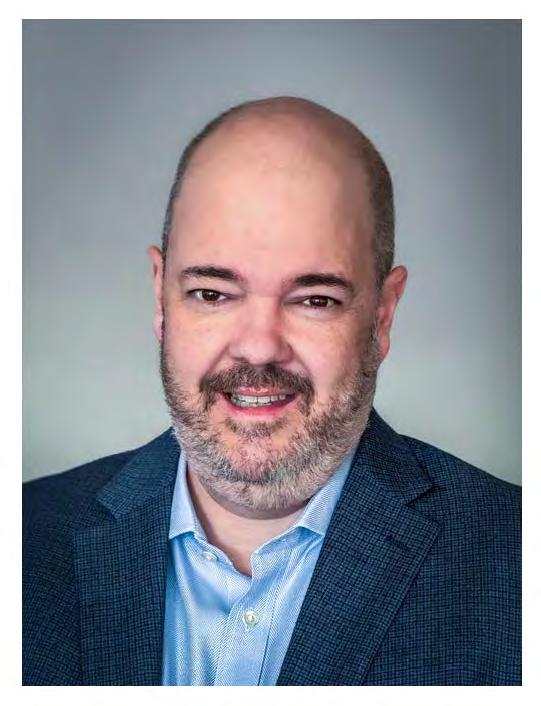 Andrew S. Kelley
Andrew S. Kelley

Outside of philately, Andrew is a business litigation attorney. Throughout his career, his practice has focused on editing other lawyers’ work to ensure that it is clear, concise, and persuasive. Andrew is also a semi-professional outdoor photographer. He has taught many classes about preparing images for publication using Adobe Photoshop and other tools. He lives in Denver, Colorado, with his wife and children.
Andrew’s contact information can be found on the masthead page of The Specialist. Please submit your articles to him as well as any forms for the two free ad inserts each member is entitled to each year.
—Nick Lombardi, President
APRIL 2024 147 Society News

FOR THE US SPECIALIST
148 THE UNITED STATES SPECIALIST
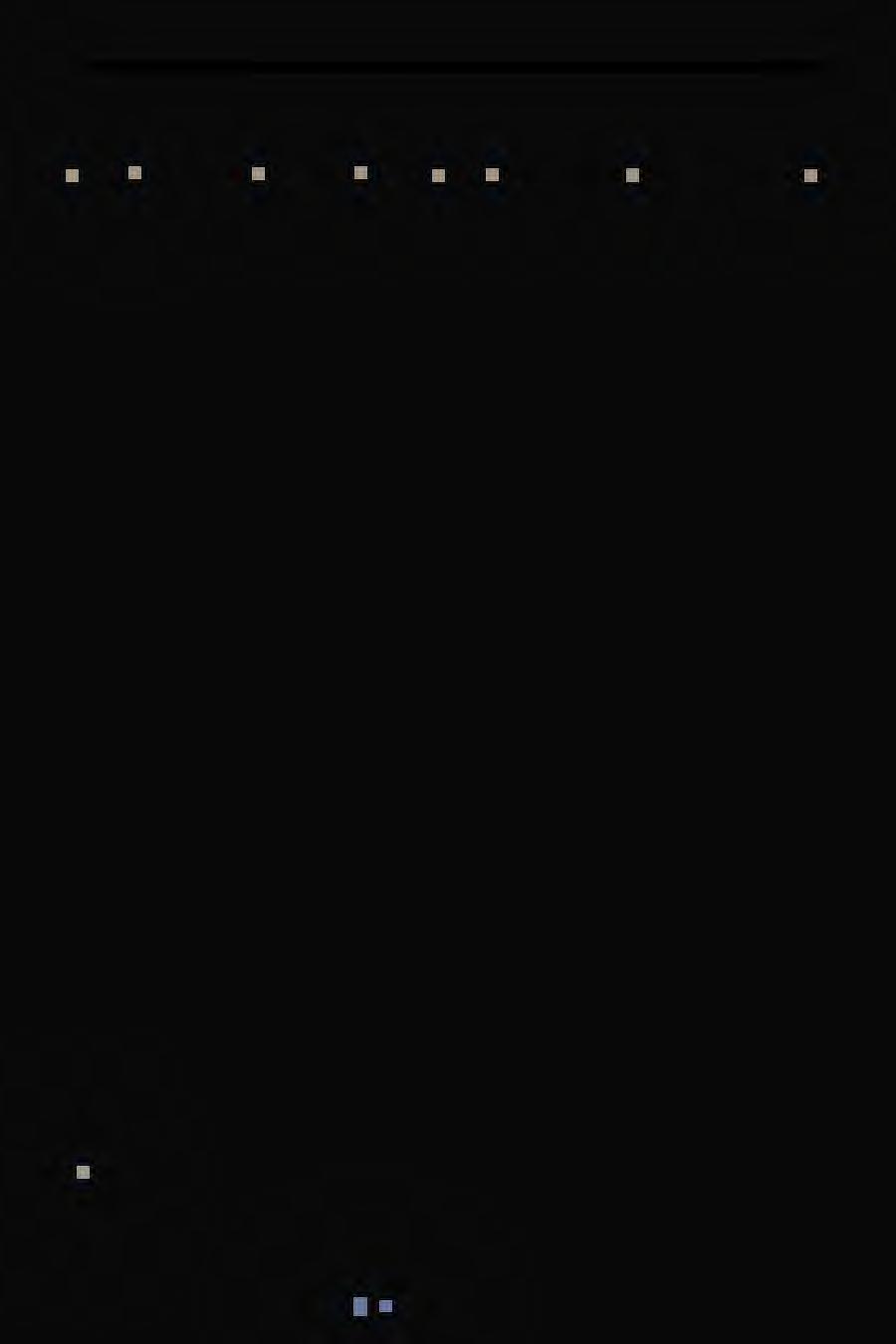
SubmiSSionS needed for The uniTed STaTeS SpecialiST
The United States Specialist depends on member-submitted content to present high-quality and diverse philatelic articles each month. At present, we have a severe shortage of material awaiting publication.
As the new editor, I am appealing to you to submit story ideas, working manuscripts and, especially, completed articles to be considered for publication. The goal is to maintain a balance between longer, multiple-part articles and short vignettes—both of which need compelling narrative and a strong philatelic thread centered around US material.
I am grateful for the great articles that have been submitted and the work that many of you are continuing. If you have contributed materials, thank you! If you have submitted material to the previous editor or to me, but have not heard back, please email again. If you haven’t submitted anything for review, please consider preparing a manuscript soon. Do not be intimidated by the process; I am happy to help polish a manuscript or perfect illustrations. The success of the journal depends on your contributions.
Considerations
When preparing materials for print, please follow the guidelines in the January 2024 Specialist, p. 28–31. (I am happy to send a copy on request.) The most important guidelines are to submit files with minimal formatting and to ensure that illustrations have sufficient resolution for print (ideally at least 300 pixels per inch).
Questions? Ideas? Please contact me at editor@usstamps.org.
—Andrew S. Kelley, Editor
APRIL 2024 149
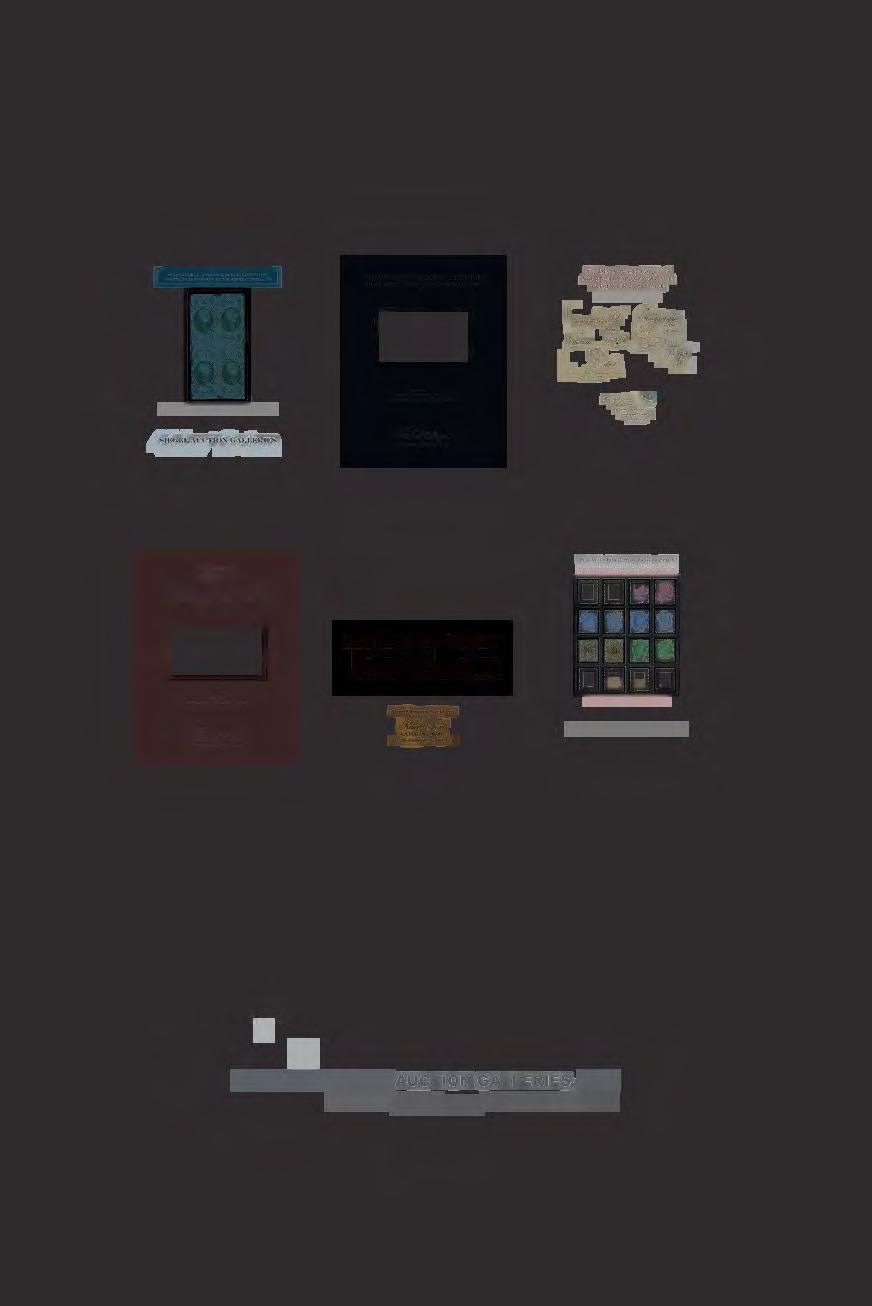
21 West 38th Street, 7th Floor New York, N.Y. 10018 Phone (212) 753-6421 Email: stamps@siegelauctions.com Great Collections have ONE NAME in common BleckwennEubanksWalske KramerGrossMooz Siegel offers unparalleled expertise, a worldwide client base, financial reliability, intelligent marketing, and the best internet resources of any philatelic auction house. Contact us today to learn more about consigning with Siegel and ensuring your legacy. -.,,.S'lHE!<ll'• H~or "°"11lA'IERK'AlllJ<do4r.<t..,WJL ...il'I\K',CH.'t,r.!l'«mW.U. n,.w,u,.-..><.t ...,.,·rn• ..,n~ ; ·"·'"'"' ,•., ,c;,;, .i QD [QlleJ lffl Iii Im II ll II [J[JQE'J ROBERT A. SIEGEL AUCTION GALLERIES, INC. Amer ica's pr emi er s ta mp auctio neer s ince 1930

Regarding Newly-Documented CIA Inverts.
I was recently re-reading some old Specialist issues when I came across a short article by Nick Lombardi regarding a deceased collector who had discovered an unreported philatelic item but, for unknown reasons, never reported it to the philatelic community. Nick goes on to say how our hobby “…thrives on shared knowledge” and reiterated the words of New York City’s post-9/11 advertising campaign: “If you see something, say something.”
This article reminded me of last year’s announcement in Linn’s by Wayne Youngblood regarding the “recent” discovery of additional CIA Inverts (Scott 1610c) almost 35 years after the original find. Apparently, during that time-period, the additional inverts were known to several prominent dealers but not the collecting public. The only reason I can attribute to this clandestine action is the ability for those involved dealers to sell non-position copies of the additional stamps without the decrease in the price that would have been
Quality US Stamps At Competitive Prices
Free pricelist available via mail or on my web site. Mint & used singles , blocks, plate blocks, & back of book.
New issue service available.
P.O. Box 549
•

• Scott A. Shaulis
Murrysville, PA 15668
scott@ shauliss tamps. com
www.shaulisstamps.com

the result of another 100 errors entering the market. So much for “shared knowledge.”
To Lombardi’s final line of his article, I would make the following change: “If you see something, say something, unless you can profit from it.”
Gene Pica USSS 13757
Send your letter to the editor via email to editor@usstamps.org. You may also mail your letter to The US Specialist, 9038 East 25th Dr., Denver CO 80238.
APRIL 2024 151 Letters to the Editor
Paying $50 St. Louis Bomar Cancel ST.L04-15, Machine 3 Terry Kurzinski
1979 $1 Rush Lamp and Candle Holder with engraved brown inverted, the CIA Invert, Scott 1610c (courtesy Siegel Auction Galleries).
tkurzinski2002@yahoo.com 815.262.9117
\\J' ::c: -n~ 5 a,: IT. vsn oo-L ouls ivoEC l~t 7 :;QPM 190\ '/);1 J.H!>ll S.Y.)11:IWY
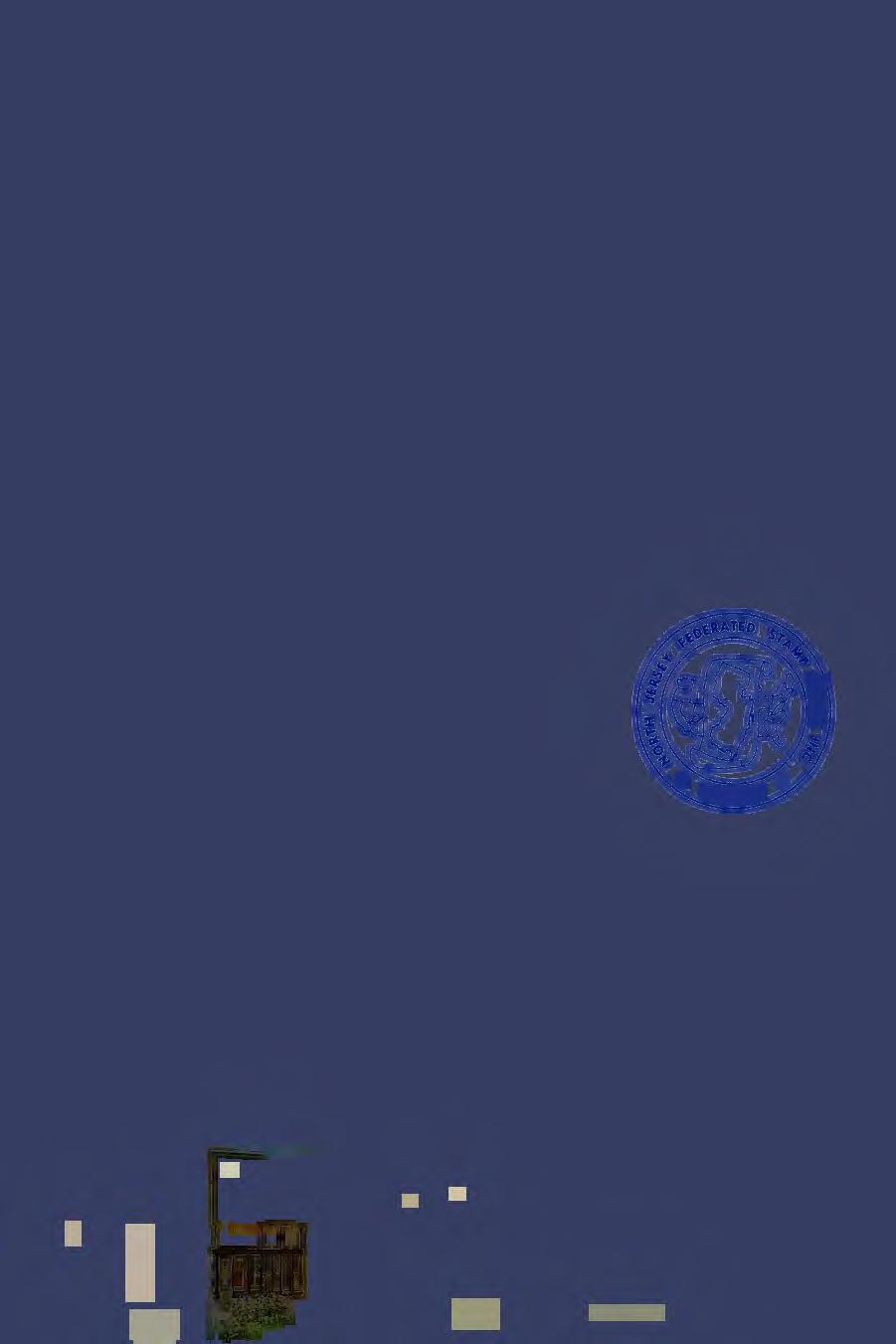
UNITED STATES STAMP SOCIETY 2024 AnnuAl Meeting NOJEX 2024 www.nojex.org Hilton Hasbrouck Heights 650 Terrace Ave. Hasbrouck Heights, NJ 07604 Special rate: $139 per night Call Hotel at 866.682.0314 Use code NOJ Save the Date Save the Date September 27–29, 2024
Plate Varieties on the Poland Overrun Countries Stamp
by Keith Lichtman
USSS # 14279 | m
stampmankeith@gmail.com
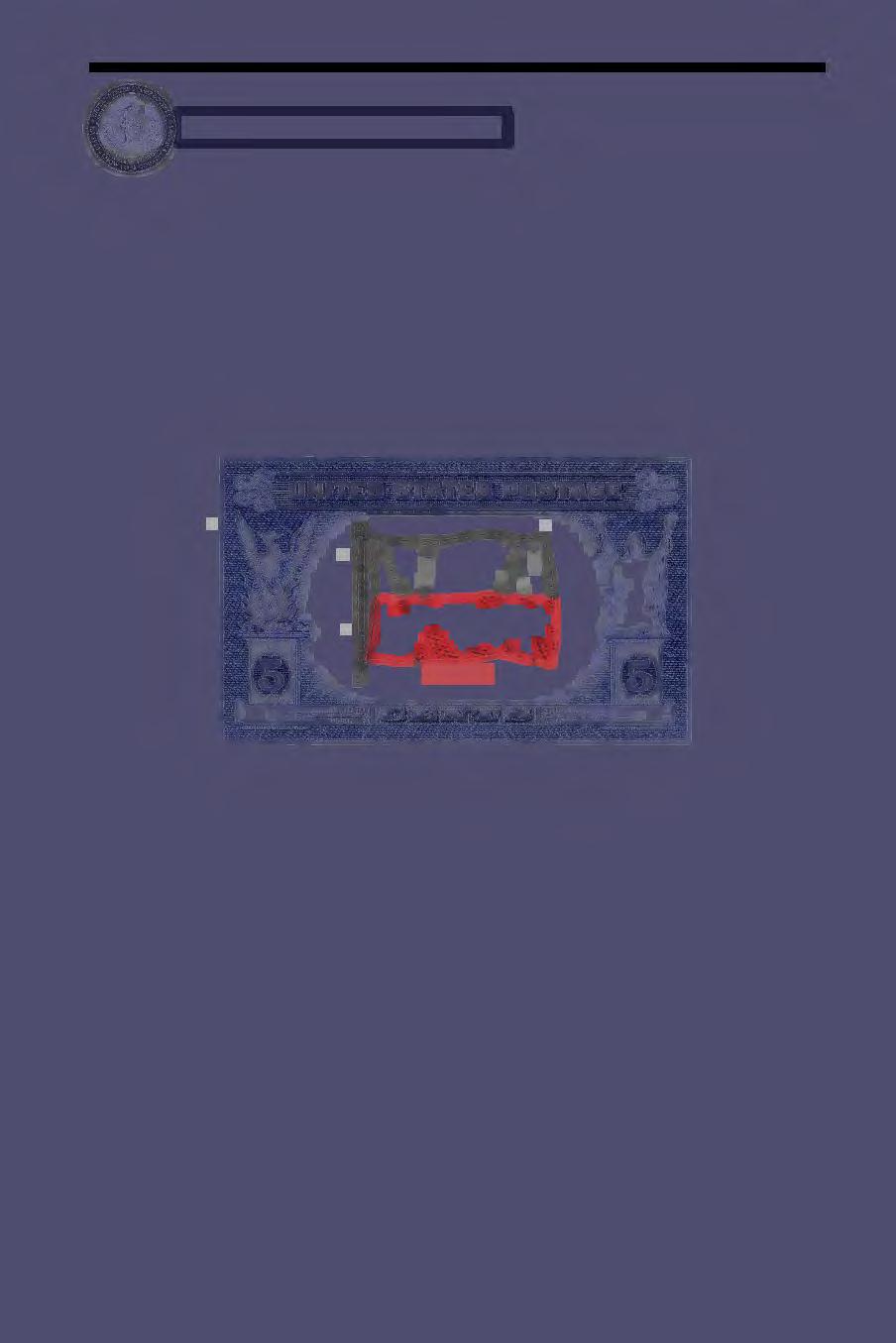
The Poland stamp, the first stamp in the Overrun Countries series, was produced by the American Bank Note Company. Its first day of issue was June 22, 1943. 19,999,646 stamps were produced in sheets of 200, four panes of 50 per sheet. The frame of the stamp is engraved. The flag and country name were printed by offset lithography.
In 1945 Sol Glass wrote in The Stamp Specialist about plate varieties found on these panes. These varieties are constant varieties, meaning that they appear in the same position in the pane through one or multiple printings. Such varieties were made by damage, alteration, or repair of the plate.
Collectors discovered additional varieties after the publication of Glass’ article; these were reported in the Encyclopedia of Plate Varieties on U.S. Bureau-Printed Postage Stamps by Loran C. French.
In my research, I have discovered some additional varieties that were not previously reported, as well as some errors in the prior literature. This article reports on these discoveries.
In the following table, UL refers to upper left pane, UR refers to upper right pane, LL is lower left pane, and LR is lower right pane. The number next to the pane designation refers to the position of a stamp on the plate.
APRIL 2024 153
Countries
Overrun
UL2 red spot inside the flag pole, 0.5 mm from the upper right corner of the red field.

UL10 a 0.1 mm line protruding from the right side of the red field, 1.5 mm from the bottom tip of the flag.
UL16 red spur at the bottom of the flag, 4.5 mm from the bottom right corner of the red field.
UL26 & LR26 upper right corner of the flag outline is broken. The gap is about 0.5 mm wide. Be aware there are many stamps that have a gap in this general area but they are usually located more on the right side of the outline and only gap .025 mm or smaller.
UL41 two red dots between the flag and the pole. The dot touching the left side of the pole is 2 mm from the upper left corner of the red field. The dot not touching the pole is 0.75 mm from the upper left corner of the red field.
UL48 & LL48 red dot over the “A” in Poland, 0.5 mm from the top of the ‘A’.
154 THE UNITED STATES SPECIALIST
UR4 red dot 3 mm from the bottom of the flag pole and 0.75 mm from the left side of the pole.
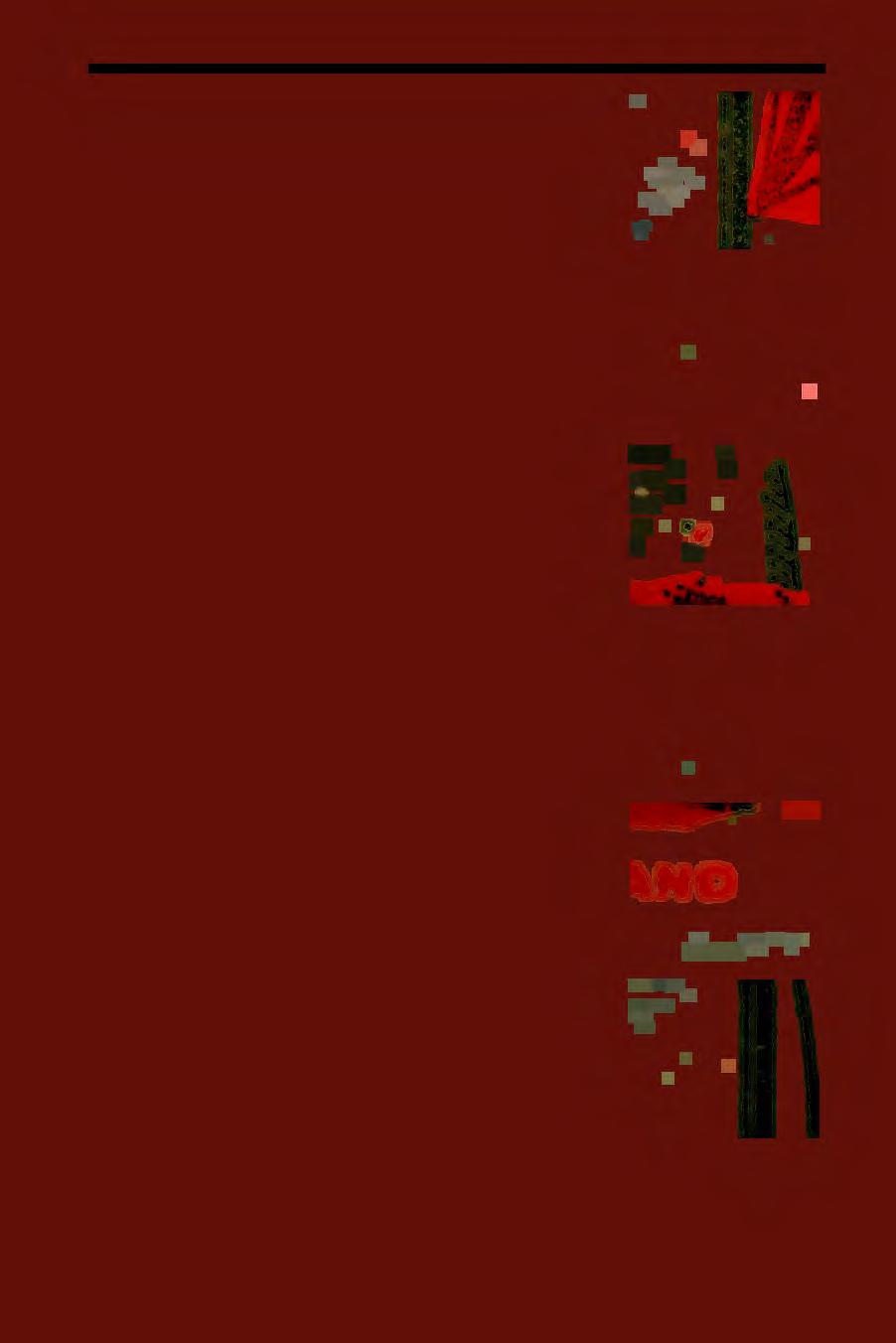
UR18 red spur on the bottom left side of the red field, 2 mm from the bottom hoist.
UR25—red spot in the white field, 1 mm above the red field and 1.8 mm from the right-side outline. This varieity listed in Sol Glass’s article but not in the Encyclopedia. I have confirmed Sol Glass’s identification.
LL3 red spot between flag and pole, 1.5 mm from bottom hoist.
LL7 “D” in Poland looks like an “O.” The left out-side of the “O” is missing that small straight line. This stamp can be difficult to identify.
LL14 red spot 1.25 mm from the left side of pole and 2.75 mm from the top of the pole.
APRIL 2024 155
,_ Ill " • • ~1 J .._, • .... • ... • • ::t lNO
LL16—red spot in lower left corner of the white field.
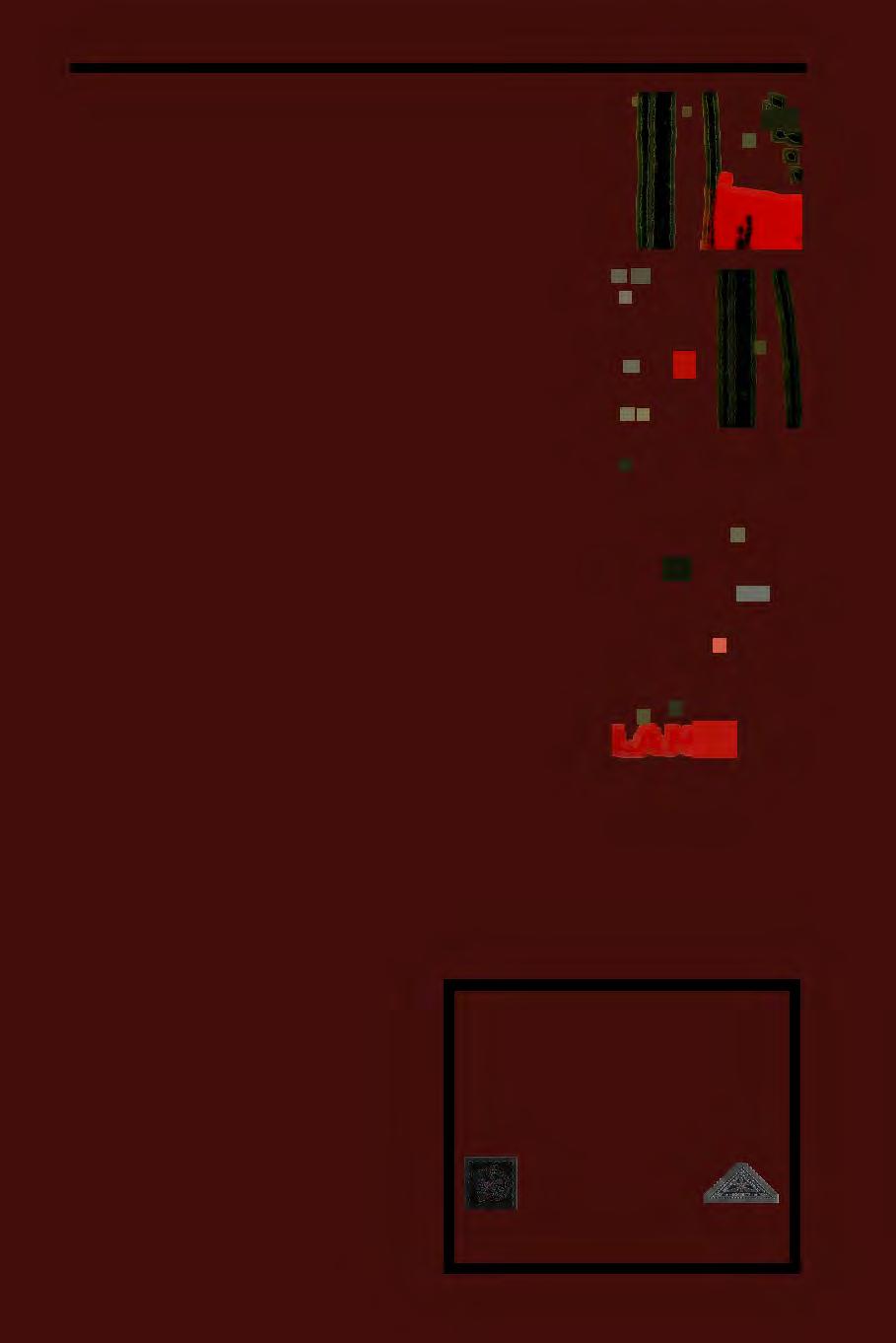
LL18 red spot 0.8 mm from the left side of the pole and 3.25 mm from top of pole.
LL44 black spot below right corner of the red field. Bottom of the round corner of the flag lines up with the top of the black spot.
LR30 red spot between the “N” and “D” of Poland. I have listed this stamp as being from lower right panes. I have not examined enough of these panes to say positively that they are lower right. I have examined enough single stamps to conclude they are plate varieties
LAN ·D
Lastly, both Sol Glass and the Encyclopedia list LL40 as “white spot in red field.” I have not found any panes with a white spot in that position.
I have not examined the shading in the flag for plate varieties. Such varieties exist and I hope to research them at a later time.
References
1. Glass, Sol. “The Overrun Nations Series.” In The Stamp Specialist Coral Book, 3–48. New York, N.Y.: H.L. Lindquist, 1945.
2. Glass, Sol. “The Overrun Nations Series, The Flag Stamps.” In The Stamp Specialist Chartreuse Book. New York, N.Y.: H.L. Lindquist, 1948.
3. French, Loran C. Encyclopedia of Plate Varieties on U.S. Bureau-Printed Postage Stamps. Whittier, CA: Bureau Issues Association, Inc., 1979.
USatFACE.com
If you collect Plate Blocks, Booklets, Coils, or Sheets, the above website, with hundreds of sets at Face Value, will be a great savings to you. Enjoy the hobby.
Armen Hovsepian (APS 150170)
P. O. Box 24222
Overland Park, KS 66283
info@USatFACE.com
156 THE UNITED STATES SPECIALIST
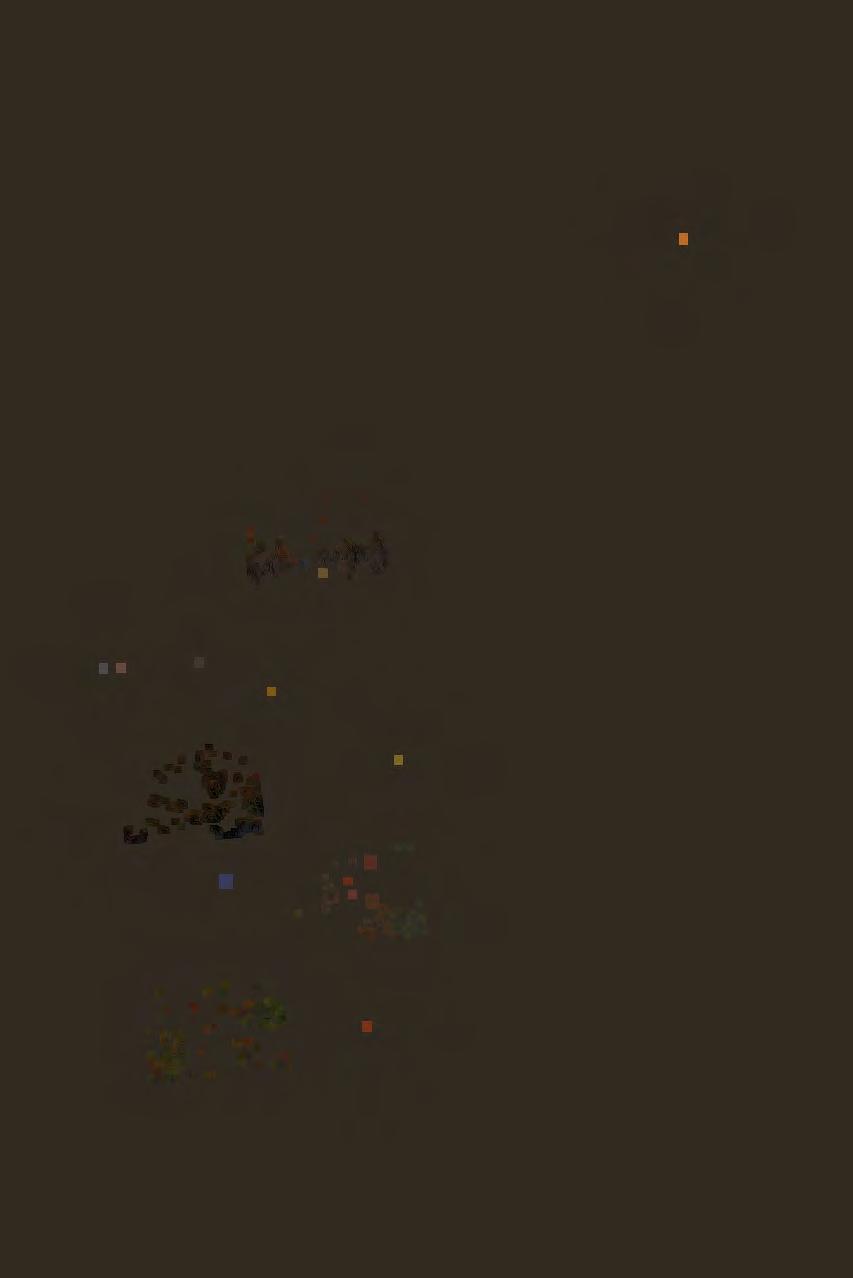
Sponsored by the United States Postal Service Hosted by the APS, AFDCS and ATA Visit www.stamps.org/GASS for current information Connecticut Convention Center, 100 Columbus Blvd., Hartford, CT 06103 Great American Stamp Show Great American Stamp Show Hartford, Connecticut August 15 – 18, 2024 Reserve your hotel rooms – special show rate $159/night + tax Sign-up information is now available for Dealers, Exhibitors, Society Booths, and Meetings/Seminars Plan Now Show Highlights • 100+ Dealer & Society Booths • First Day Ceremonies • Live Auction • 800+ frames of Stamp exhibits & rarities • Youth Activities/Boy Scout Merit Badge Workshop • Federal Duck Stamp Art Display • Seminars & Social Gatherings ,,- - ~~ . -, _;--. ,w; .... ~\ ' • I<'• I~ ' \,.-lui t ~, , ,',, l .~ - ~;>.:).:, o ' ~' • ~ \
Rutland Railroad “Emergency” Handstamp
by Roger S. Brody
USSS # 11814 | m brody@usstamps.org

Boston, Mass.
What was the emergency in the unusual “Emergency” handstamp used in February 1904 on the Rutland Railroad envelope that caught my eye in an early 1990 auction. Was it a fire, a washed-out bridge, or perhaps a train wreck?
To learn more about the handstamp I contacted Ruth Henson, editor of The Vermont Philatelist. She kindly pointed the way, and the cast of characters and amount of information blossomed.
The primary transporter of the mails at the turn of the twentieth century was the Railway Mail Service. Regulations for the thousands of RMS employees were established to insure the efficient movement of the mail. The rules covered everything from guarding the mail and trip reports to postmarking to identify when and who handled mail matter as it moved from one point to another across the country. Accountability was the watchword of the RMS.
Emergency Postmarkers
The Division Superintendent of the Railway Mail Service issued the Emergency markers for use when a clerk lost his postmarker or was unable to perform his duties. The term “emergency” is more generic when used for this particular purpose, as it only Postal
158 THE UNITED STATES SPECIALIST
History
RUTLAND RAILROAD.
R. R. B.
1
Bhepart' and Morse Lumber Oo

means that a postmarker was not otherwise available for that particular route when needed by the person acting as the Clerk-in-Charge on that RPO, according to Frank Scheer of the Railway Mail Service Library.
In the absence of a postmarking handstamp that shows the route, spare “emergency” postmarkers were kept in the Chief Clerk’s office. Since they were accountable property, they would be issued to the Clerk-in-Charge when needed, then returned when an appropriate postmarking handstamp became available, usually through procurement of a new device. Reports and postmarked mail matter could be traced by seeing to whom an emergency handstamp was issued on that date, as each handstamp was distinctive. When the emergency postmarker could not be delivered, clerks would use anything they could find, such as a different route marker or an obsolete marker. Unfortunately, records of the use of “emergency” markers do not exist today.
Lyle K. Rice, of Rutland Vermont, RMS retired, was assigned to the Rutland, Vermont, Terminal with Transfer Clerk duties starting June 1, 1934. He believes that this particular “emergency” handstamp might have been used by a Substitute Clerk who lacked a device. The regular Clerks on regular runs always made up a Letter Pouch for the Clerk or Clerks due to take the assignment next. If a Substitute was assigned in place of a regular Clerk, it was the duty of the regular Clerk to make sure the Substitute had the postmarking device and, sometimes, even the revolver in case the Substitute was never assigned such an object. Chief Clerks probably had one or more of the emergency devices at their office, but more likely, a Transfer Office was the supplier for Rutland’s emergency use.
The circular date portion of the illustrated “emergency” duplex postmarker on the Rutland Railroad cover measures 29.5mm in diameter. The killer portion is a 9 bar oval, 29mm high. Fred D. MacDonald, editor of the Mobile Post Office Society’s United States RPO Catalog believes that only the First Division of the RMS used this type of marker as none have been reported for the other Divisions. The mark, (see tracing above) in black ink, is dated February 20, 1904. The RPO Catalog lists this type of marker as type #49-F-3, which was previously only known to be used in 1903.
Rail Road Business
Frank Scheer identifies the “R.R.B.” initials in the lower left corner of the cover as “Rail Road Business.” “R.R.B.” was a franking required for mail, internal to a railroad, permitted by federal law to pass through the RMS without postage. Frank says “R.R.B.” was a practice widely used for railroad company mail matter and could also frank mail from one railroad to another. The author was, however, unable to cite such a provision in the Postal Laws and Regulations of the time. This particular Rutland Railroad envelope was used by a railroad employee for communication to a non-railroad office (possibly a shipping client) in Boston, thus requiring the two-cent first class postage rate.
The exact reason for the use of the “Emergency” postmarker on the Rutland Railroad cover is lost to the past. Lyle Rice muses the lack of the regular postmarking device could occur under several conditions, not the least of which was the possibility that a mail car burned in transit. [This article originally appeared in the Vermont Philatelist -Ed]
APRIL 2024 159
A New Type of the Retouched on Cheek Variety on Scott 528B
by Andrew S. Kelley
USSS # 16734 | m stamps@andrewkelley.net

The retouched on cheek variety—found on Scott 528B—is the most spectacular “plate” variety on the Washington-Franklin Heads printed by offset lithography.1 See Figure 1. Philatelists have been writing about this variety for nearly a century, so it was surprising to discover an unreported second type of this retouch, which appears to be a heavier version of the first. See Figure 2. This article reports on the new variety and analyzes its origin.
Background
Offset platemaking was a complex, multi-step, largely photographic process. See Figure 3.2 The many steps and fragile materials generated many varieties. Foreign matter on the photographic materials and damage to and imperfections in those materials created “plate” flaws. For example, a scratch on a negative would create a line of color. In other cases, a bit of paper stuck to the master negative generated a blank spot on the finished stamps. Consider plate 11950: this oversize plate (1600 subjects) was made by exposing an ordinary-size 400-subject negative four times. Some positions have a white blotch caused by a piece of foreign matter adhering to the negative. Remarkably,
160 THE UNITED STATES SPECIALIST
From the Washington-Franklin Head Commitee
Figure 1. Previously documented “light” retouch (photographic crop from Figure 6).
Figure 2. Newly-discovered “heavy” retouch.
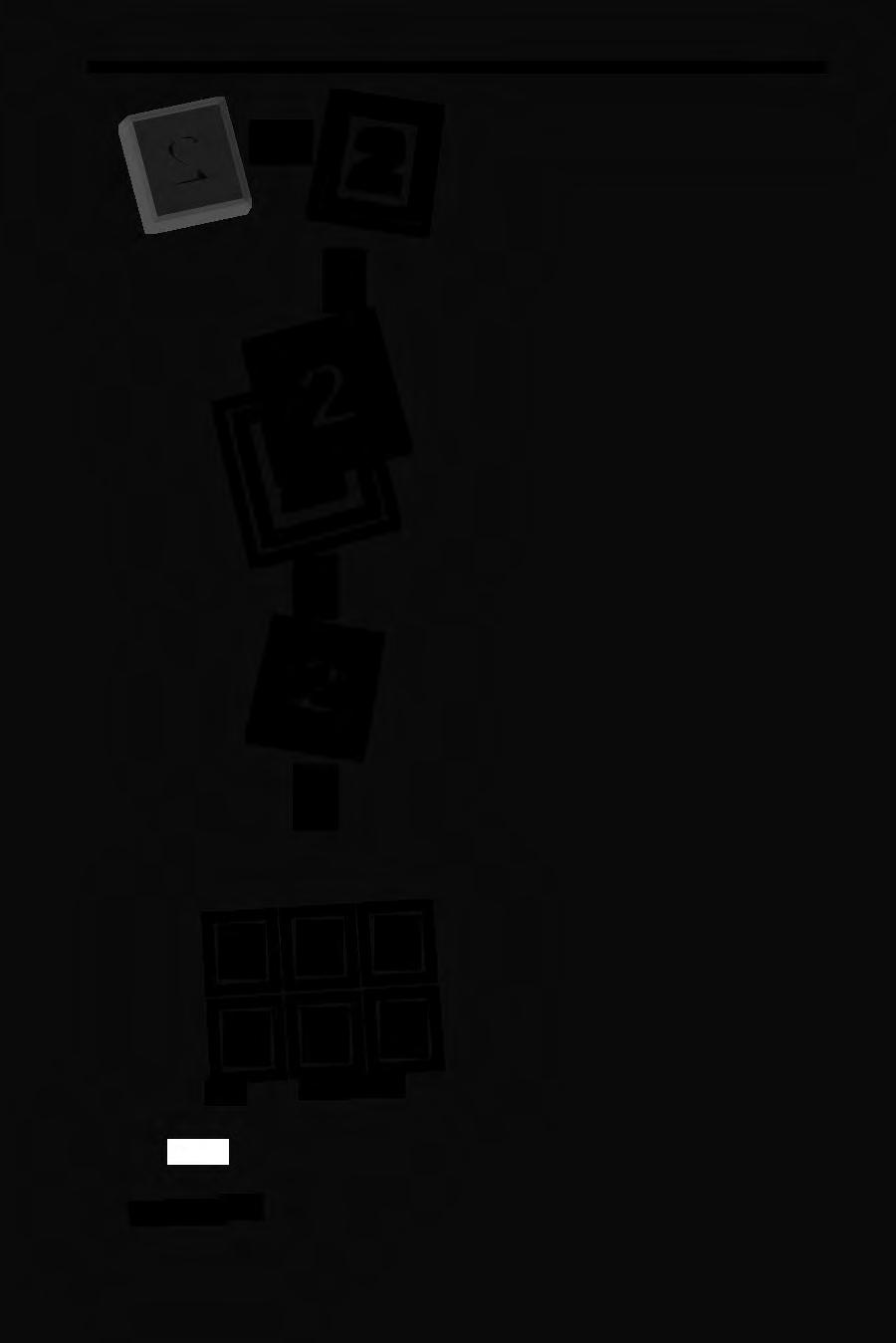
The Offset Platemaking Process
1. Traditional die proof pulled from engraved die.
2. Enlarged negative made by photographing die proof and positive made from negative. Lines retouched and strengthened on positive to adapt design to lithography.
3. Stamp-sized “step-down” negative made from retouched positive.
4. Glass positive created by using the step-down negative in a step-and-repeat photo compositing machine to expose 400 subjects on glass plate, one at a time.
5. Celluloid master negative made from glass positive.
6. Zinc printing plates made from master negative by contact photographic printing. Single master negative used to create many plates.
APRIL 2024 161
Enlarged
Retouched Positive
400 Subject Glass
Engraved Steel DieDie Proof
Negative
Stamp-Size Step-Down Negative
Figure 3. Schematic of the lithographic plate making process.
Zinc Printing Plate

the foreign matter moved between exposures, and so some lower left plate blocks have no flaw, some have a flaw affecting the “P” of Postage, and some have a flaw affecting the “o” as shown in Figure 4.3
Lithographic platemakers attempted to repair prominent flaws. Figure 5 shows a repair to the “P of Postage” flaw discussed above. Of these repairs, the retouched on cheek variety is the most famous. Lybarger and Johl illustrate it in their books, and it has also attracted attention from philatelic columnist George Sloane, offset specialist David Bennett, and others.4
We don’t know precisely how the Bureau made these retouches. Donald Lybarger, dean of the offset experts, claims that the retouch was made directly on the printing plate. 5 He is, however, vague on the details of how this was accomplished. George Sloane asserted that it was impossible to retouch offset plates directly6 and that the retouched on cheek variety was made “by patching it [a flaw on the negative] over with a little opaque, directly on the film.”7
We can discount Sloane’s view: adding opaque to a negative would not fix a white spot on the stamp, it would create one: opaque areas on a negative print white. (See the white spot on Figure 4 for an example.) Moreover, flaws like the missing “P” or “o” in Postage must have been repaired on the plate, not on the negative, because the flaw was on the plate, not the negative. So, we know that the Bureau could make repairs on the plate. And the retouches in Figures 1 and 2 look like they were painted on the plate, not scratched into it. But, I am not aware of documentation about how these repairs were made.
What We Know about the Retouched on Cheek Variety
Despite its philatelic fame, we do not know much about the retouched on cheek variety. We know that it comes from the eighth row of an upper pane, as demonstrated by the block in Figure 6.
We also know—or at least infer—that the variety was printed in a small quantity, possibly from a single plate. The variety is quite scarce: Bennett found only four examples in thirty years of searching.8 Aided by modern tools like eBay, I have found more
162 THE UNITED STATES SPECIALIST
Figure 4. Scott 528 with flaw in “o” of Postage, LR stamp caused by foreign matter on the negative.
Figure 5. Scott 528 with repaired flaw in the “P” of Postage, left stamp.
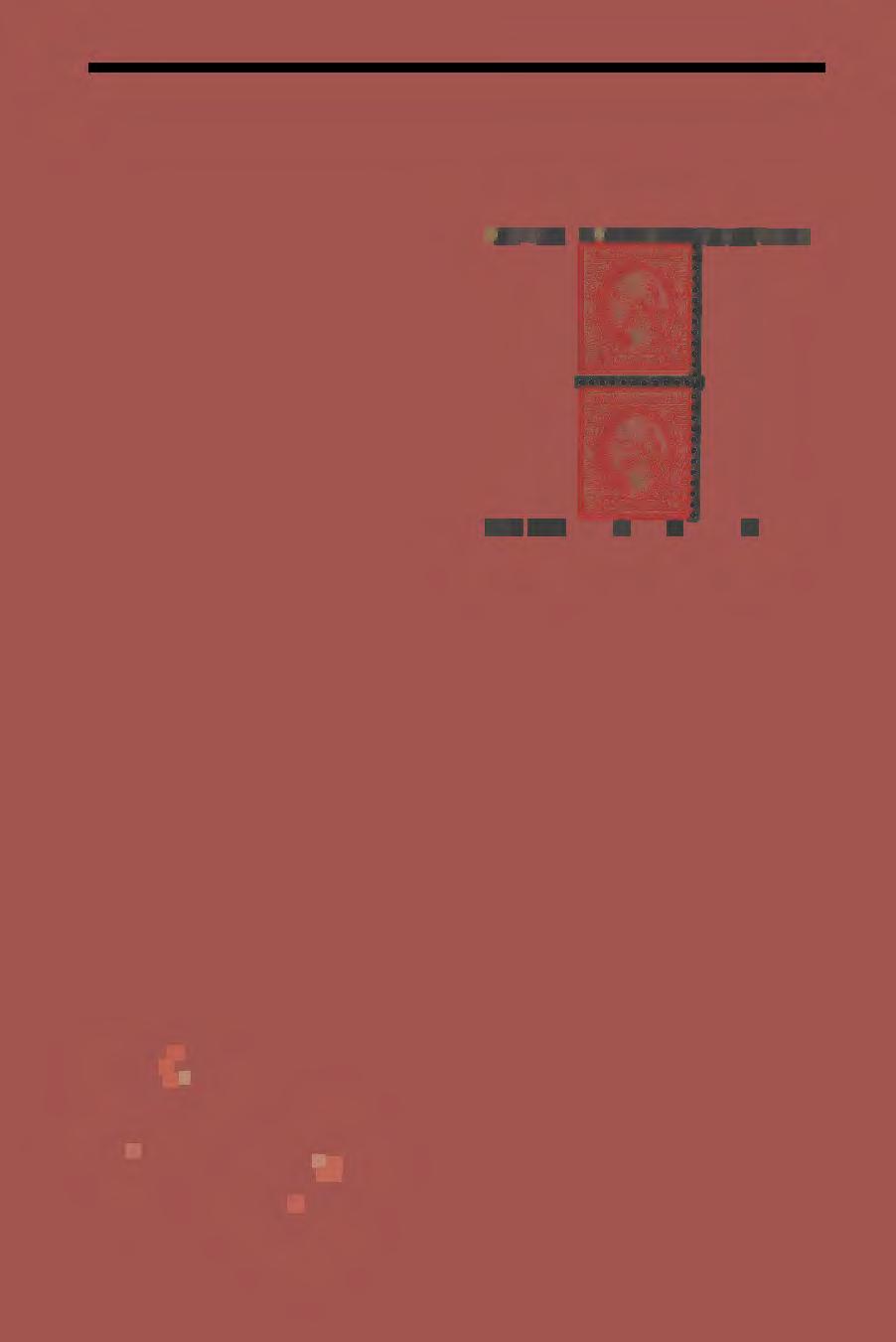
examples than that. But I would be surprised if there are more than ten in collector hands. The variety is notorious for poor centering.9 The design is close to the perforations at right on all examples I have seen. The scarcity and similar copy-to-copy centering suggest that few of the retouched on cheek varieties were printed, and that (perhaps) they were all perforated close in time on the same machine.
Unfortunately, we do not know which plate(s) have the retouch. 10 Collectors have searched for the retouched subject or the antecedent plate flaw among the proof sheets at the Smithsonian but turned up nothing.11
From this information, specialists, including me, infer that the variety was confined to a single plate. If the damage and retouch were on a master negative or glass positive, they would likely be present on many plates, and we would expect to see many more copies in collector hands. And, of course, we would find it on proof sheets from those plates. If the single plate theory is correct, the damage and repair must have happened after the proof sheet was printed—after the plate was mounted on the press for production.
Origin of the New Variety
In early 2020, I discovered the “heavy” version of the retouch. Prior to this discovery all the reported examples of the retouch were the “light” variety.12 See Figure 7 for enlargements of the two types. I have searched unsuccessfully for additional examples
APRIL 2024 163
Figure 6. Light retouch margin block demonstrating retouch comes from an upper pane. Note large vertical scratch on subject above the retouched stamp.
Figure 7. Enlarged and colorized images of the retouches. “Light” retouch at left, and “heavy” retouch at right.
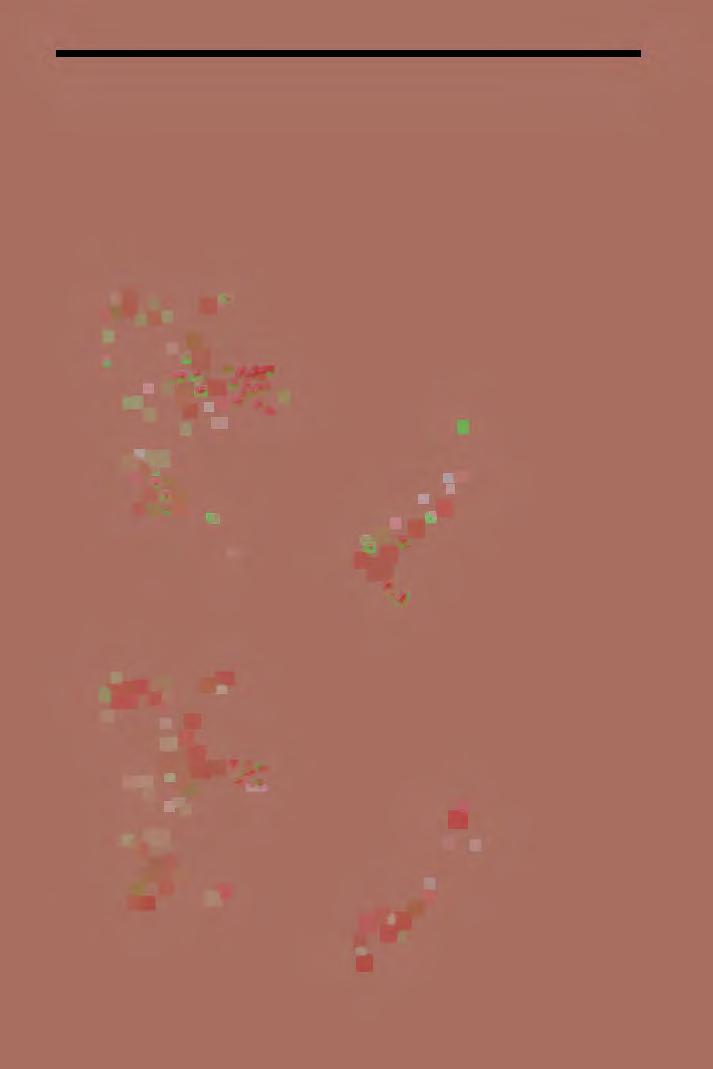
of the heavy retouch on the Internet, at stamp shows, and by polling members of the Washington-Franklin Head Committee. I have found none.
There are three possible sources of the two types: (1) two different retouches, applied to different subjects on a plate or a master negative; (2) two different retouches applied to the same subject on the same plate; or (3) a single retouch, which wore away over time.
To assess these alternatives, I compared the two retouches using Adobe Photoshop.
In Figure 8, the light retouch, in red, is layered on top of the heavy retouch, in green. The green color shows the portions of the heavy retouch that do not appear on the light retouch. Figure 9 is the reverse, with the light retouch on the bottom and the heavy
164 THE UNITED STATES SPECIALIST
Figure 8. Comparison of light and heavy retouch. Green shows areas on the heavy retouch that are not present on the light retouch.
Figure 9. Inverse of Figure 8. Green shows areas of the light retouch that are not present on the heavy retouch.
retouch on the top. The green shows portions of the light retouch that do not appear on the heavy retouch.
As these two figures demonstrate, the light retouch is almost completely contained within the area of the heavy retouch. However, there are small portions of the light retouch that do not appear on the heavy version.
These images give important clues to the genesis of the variety. We can quickly rule out the first explanation, that the two retouches come from different positions on the plate or master negative. The overlap between the two varieties is too perfect for them to represent separate free-hand retouches.
The second explanation, that the plate was retouched twice, is slightly more plausible. On this theory, the light retouch came first and was later re-retouched to make the heavy version. This could explain the lack of complete overlap between the heavy and light retouches—part of the design wore away before the second (heavy) retouch. However, this explanation strikes me as unlikely. There is little aesthetic difference between the light and retouches; why bother with a second retouch? Moreover, the horizontal lines (brush strokes?) on the two retouches overlap almost perfectly, which seems unlikely if portions of the design were applied twice.
That leaves the third explanation, that the light retouch is a worn version of the heavy one. This is the best explanation for the nearly-total overlap between the retouches. This attribute strongly suggests that the retouches are the same but part of the retouch wore away or flaked off after the heavy retouch was printed. Also, the light retouch example shows some other signs of wear: some of the shading dots outside of the retouch are darker on the heavy retouch than the light. While there are a few small areas in the light retouch that do not show up in the heavy retouch, these minor differences can be explained by the vagaries of offset printing and poor-quality paper. Minor sample-to-sample variations on offsets stamps are typical
I welcome reports of examples of the retouched on cheek variety.
Thanks to Larry Weiss and Tom Bodem for helpful comments on a draft of this article, and to the members of the Washington-Franklin Heads Committee for reviewing it.
Endnotes
1. This variety is sometimes called the “birthmark variety.” See, for example, Weiss, “Why Collect the U.S. Washington-Franklin Heads? A 100th Anniversary Tribute Part III,” 42. However, this article will use the Scott Specialized Catalog description “retouched on cheek” while acknowledging that it is grammatically awkward.
2. This figure is my recreation of an illustration from Lybarger, The United States Issues of 191820, 5. For more information about offset platemaking and printing please refer to his book.
3. French, Encyclopedia of Plate Varieties, 115.
4. Johl, United States Postage Stamps 1902-1935, 179; Lybarger, The United States Issues of 1918-20, 23; Sloane, “1920, 2c Offset Printing Retouch

on Cheek”; Bennett, “Varieties on the Offset Printing Issue of 1918-20,” 277; Hoeft, “U.S. 2c. Postage Stamp of 1920 and a Description of the Offset Method of Printing”; French, Encyclopedia of Plate Varieties, 119.
5. Lybarger, The United States Issues of 1918-20, 23 (“One of the stamps . . . developed a large white spot on the cheek of Washington’s portrait . . . The zinc plate was therefore retouched by a series of horizontal strokes which partially covered the spot.”).
6. Sloane, “1920, 2c Offset Printing Retouches” (“Because of the limitations of the offset printing process, it is not possible, I understand, to retouch the plate itself, and any spot or other defect noticed in the negative must
APRIL 2024 165

be corrected, wherever correction is possible in the negative, or the imperfection will be reproduced in the zinc plate”).
7. Sloane, “1920, 2c Offset Printing Retouch on Cheek.” Opaque in this context is a thick fluid used on photographic negatives to block out unwanted specks, portions of an image, etc.
8. Bennett, “Varieties on the Offset Printing Issue of 1918-20” (“While many collectors may have seen pictures of this variety, we doubt that more than a very few have seen the actual stamp itself. We have found it to be quite scarce. In over 30 years of constant searching, we have come across exactly four examples of this variety”).
9. Johl, United States Postage Stamps 1902-1935, 179 (“For some unknown reason, this variety is generally found off center”).
10. Bennett, “Varieties on the Offset Printing Issue of 1918-20,” 278. Bennett reports a rumor that the flaw might be from plate 13026, but he was unable to corroborate that information.
11. Ibid., 277–78 (“All efforts to establish its position in the pane, including examination of the proof plates at the Smithsonian Institution,
Bibliography
Bennett, David M. “Varieties on the Offset Printing Issue of 1918-20.” The United States Specialist 43, no. 6 (June 1972): 274–78.
French, Loran C. Encyclopedia of Plate Varieties on U.S. Bureau-Printed Postage Stamps. Whittier, CA: Bureau Issues Association, Inc., 1979.
———. “Important Plate Varieties on the Bureau Issues.” The Stamp Lover, December 1971, 172.
Hoeft, George Eliot. “U.S. 2c. Postage Stamp of 1920 and a Description of the Offset Method of Printing.” Scott’s Monthly Journal 17, no. 4 (April 1936): 65–67.
Johl, Max G. United States Postage Stamps 1902-1935. 1937. Reprint, Lawrence, MA: Quarterman Publications, Inc., 1976.
Kelley, Andrew S. “New Variety Reported on Scott #528A - Foreign Object on Offset Roller.” The United States Specialist 91, no. 11 (November 2020): 515–18.
Lybarger, Donald F. The United States Issues of 1918-20. Federalsburg, MD: American Philatelic Society, 1937.
“Shift Hunter Letter,” no. 51 (September 1932).
Sloane, George B. “1920, 2c Offset Printing Retouch on Cheek.” Stamps 5, no. 12 (December 23, 1933): 425.
proved fruitless. All we can say about it is that it occurs in the 8th row of an upper pane, and that it occurs on one plate only.”).
12. I have found nine illustrations of the variety; all show the light retouch, though with slight variations from example to example: “Shift Hunter Letter”; Sloane, “1920, 2c Offset Printing Retouch on Cheek”; Johl, United States Postage Stamps 1902-1935, 179; Lybarger, The United States Issues of 1918-20 , 23; Hoeft, “U.S. 2c. Postage Stamp of 1920 and a Description of the Offset Method of Printing,” 67; Bennett, “Varieties on the Offset Printing Issue of 191820,” 277; 42; French, “Important Plate Varieties on the Bureau Issues”; French, Encyclopedia of Plate Varieties; and Weiss, “Why Collect the U.S. Washington-Franklin Heads? A 100th Anniversary Tribute Part III,” 42. (Some of these illustrations may be of the same stamp.) Additionally, my example of the heavy touch appeared in two recent articles in the Specialist: Kelley, “New Variety Reported on Scott #528A - Foreign Object on Offset Roller,” 516; Weiss, “Chasing the Dr. David M. Bennett Collection of 1918-20 Offset Issues,” 130.
———. “1920, 2c Offset Printing Retouches.” Stamps 5, no. 6 (November 11, 1933): 209.
Weiss, Larry S. “Chasing the Dr. David M. Bennett Collection of 1918-20 Offset Issues.” The United States Specialist 95, no. 3 (March 2024): 127–38.
———. “Why Collect the U.S. WashingtonFranklin Heads? A 100th Anniversary Tribute Part III.” The United States Specialist 80, no. 1 (January 2009): 36–44.
166 THE UNITED STATES SPECIALIST
2024 HEBERT’S All New and Revised Mint and Used Plate Number Single Catalogue $36 postpaid Expanded pricing, back-of-the-book, tag/paper varieties, PN/ZIP/ME types Rick Burdsall / APNSS P.O. Box 1023 Palatine, IL 60078-1023

• In a 352,000 square foot contiguous exhibition area, BOSTON 2026 WORLD EXPO will be hosting a large dealer and postal administration bourse, as well as a large society presence and hundreds of meetings/events. • There will be a competitive exhibition of approximately 3,500 frames, plus other special/court of honor exhibits, as well as a large literature competition. The Twelfth International Philatelic Exhibition of the United States proudly presented by
• The Boston Convention and Exhibition Center is located fifteen minutes from Boston Logan International Airport. It is ten minutes from South Station and Amtrak Acela Express to New York City and Washington DC.
• All show hotels will be within walking distance.
May 23–30,
at the
at the
Seaport Contact us at Boston 2026 World Stamp Show, Inc. P.O. Box 904, Sudbury, MA 01776 Scan Our QR Code Boston 2026 World Stamp Show, Inc. See You in Boston! Boston 2026 World Stamp Show, Inc. Boston 2026 Seed Funding Provider Boston 2026 Major Society Sponsor Boston 2026 Society Sponsor www.Boston2026.org Stay Up-to-Date on All the Show News, by visiting Boston 2026 Major Society Sponsor
2026
Boston Convention & Exhibition Center
Boston

168 THE UNITED STATES SPECIALIST
Vintage Photo of the Month
Absalom Markland, Special Agent
US Post Office Department
by
Rodney A. Juell USSS #13852 | P.O. Box 3508, Joliet, IL 60434
of the
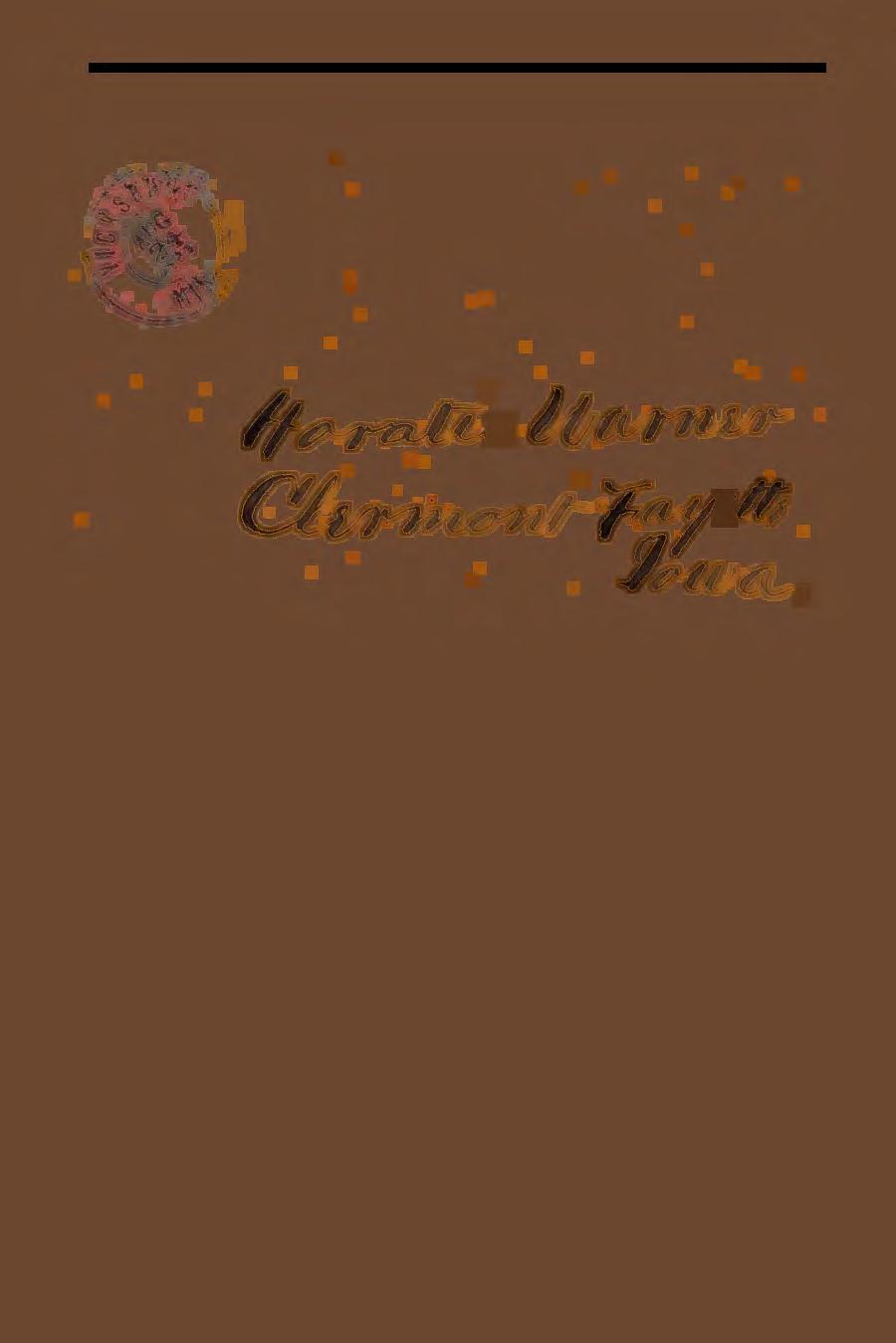
Absalom Markland, shown in this month’s vintage photo, a Special Agent of the United States Post Office Department, and organizational genius, was an unsung hero of postal operations during the Civil War. (His title of “colonel” was honorific. He was a civilian.) He efficiently supervised the movement of vast quantities of mail to and from members of the Federal forces, even while they were on the march. As areas of the south were liberated from Confederate control, Markland was right behind the army, quickly reestablishing civilian mail service under the jurisdiction of the US Post Office Department.
Shown above is a cover mailed from the United States post office in Vicksburg, Mississippi, shortly after the decisive July 4, 1863 battle in which Ulysses Grant reclaimed that city from the confederates. Markland reopened the federal post in Vicksburg the next day.
For a worthwhile biography of Markland, readers are referred to the recently (2023) published Delivered Under Fire by Candice Shy Hooper.
APRIL 2024 169
.. . . . I/~ tl;rv,n ,;,._ : . . . • • ~ ~ ~ ~tlti . . ·• · - 2 ~Ut-iA ... ~, '
From The Farley Era Committee

1938 Bi-Color Airmail Stamp: FDR, Farley and National Air Mail Week, Part II
by Paul M. Holland
pholland.thorleaf@gmail.com
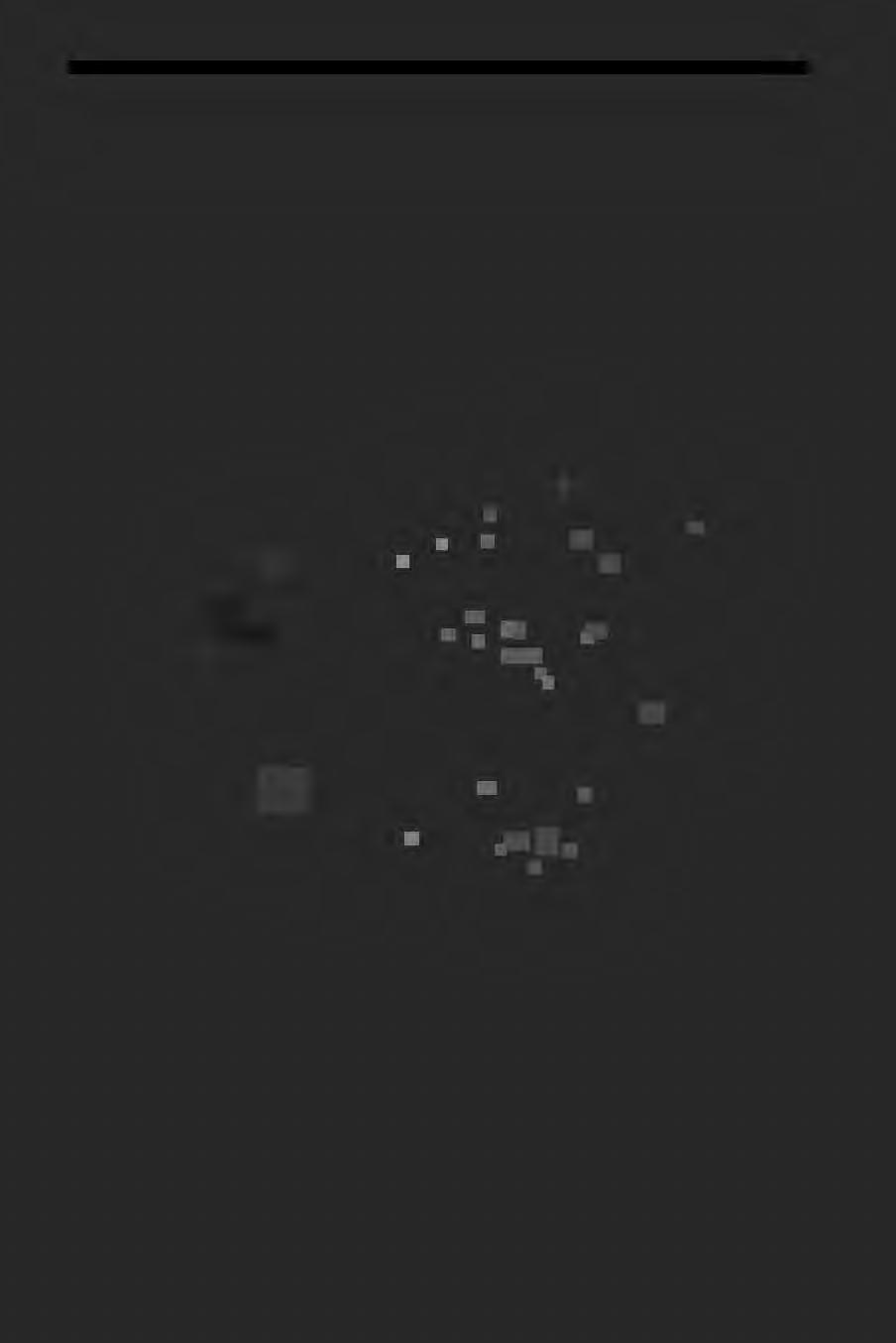
During National Air Mail Week (NAMW) May 15–21, 1938, more than 16.2 million items were sent by airmail, the majority franked using the newly designed 6¢ bi-color airmail stamp. With the slogan “Receive Tomorrow’s Mail Today” Postmaster General James A. Farley had requested that everyone send an airmail letter during the week. The massive increase over the usual amount of airmail that resulted helped promote the use of airmail service across the nation. Locally produced artwork appeared on distinctive NAMW cachets that were produced by volunteers and civic organizations. These celebrated local attractions, products and historical events linked to the numerous cities and towns participating in National Air Mail Week. This outpouring of authentic Americana provides collectors today with fascinating mementos of a bygone era. I’m fortunate in having a number of both Farley and FDR covers from NAMW in my collection that help illustrate the wide variety of artwork produced.
170 THE UNITED STATES SPECIALIST
Postmaster General James A. Farley poses with mail from National Air Mail Week.
USSS #16849 | m
The Honorable James Farley Postmaster General Washington,D.C.

The cachets used for these NAMW covers were not always printed on the envelope. Addressed to Farley and shown in Figure 1 is my Sunday May 15, 1938, example from New Britain, Connecticut that employs a printed label instead. Proclaiming New Britain as the “Hardware City of the World,” it shows the city seal with reference to native son Charles K. Hamilton, a famous early aviator whose June 13, 1910, round trip flight from New York to Philadelphia was the first flight between two major US cities, winning him a $10,000 prize. Nicknamed the “crazy man of the air,” Hamilton was especially known for his dangerous dives and spectacular crashes.
Hon. James .A.. Je.rleyPostmaster General, Washin~ton, D. C.
Custom rubber stamped cachets were more commonly used on NAMW covers, such as my Farley example shown in Figure 2. This May 15 cover from Ellsworth, Maine, displays a map showing various local attractions including The Black House (museum
APRIL 2024 171
Figure 1. Farley NAMW cover from New Britain, Connecticut.
NATIONAL AIR MAIL WEEK MAY15-21 NEW BRITAIN C O N N l C T I C U T .., VIA AIR MA I L
Figure 2. Farley NAMW cover from Ellsworth, Maine.
and estate), Acadia National Park, a local art and music colony, and the nearby Bar Harbor airport.
A more finely printed Farley example for Richmond, Virginia is shown in Figure 3. From May 16, this commemorates the 1865 Richmond post office as “the only building left intact in the burned Area at the Evacuation of Richmond” during the American
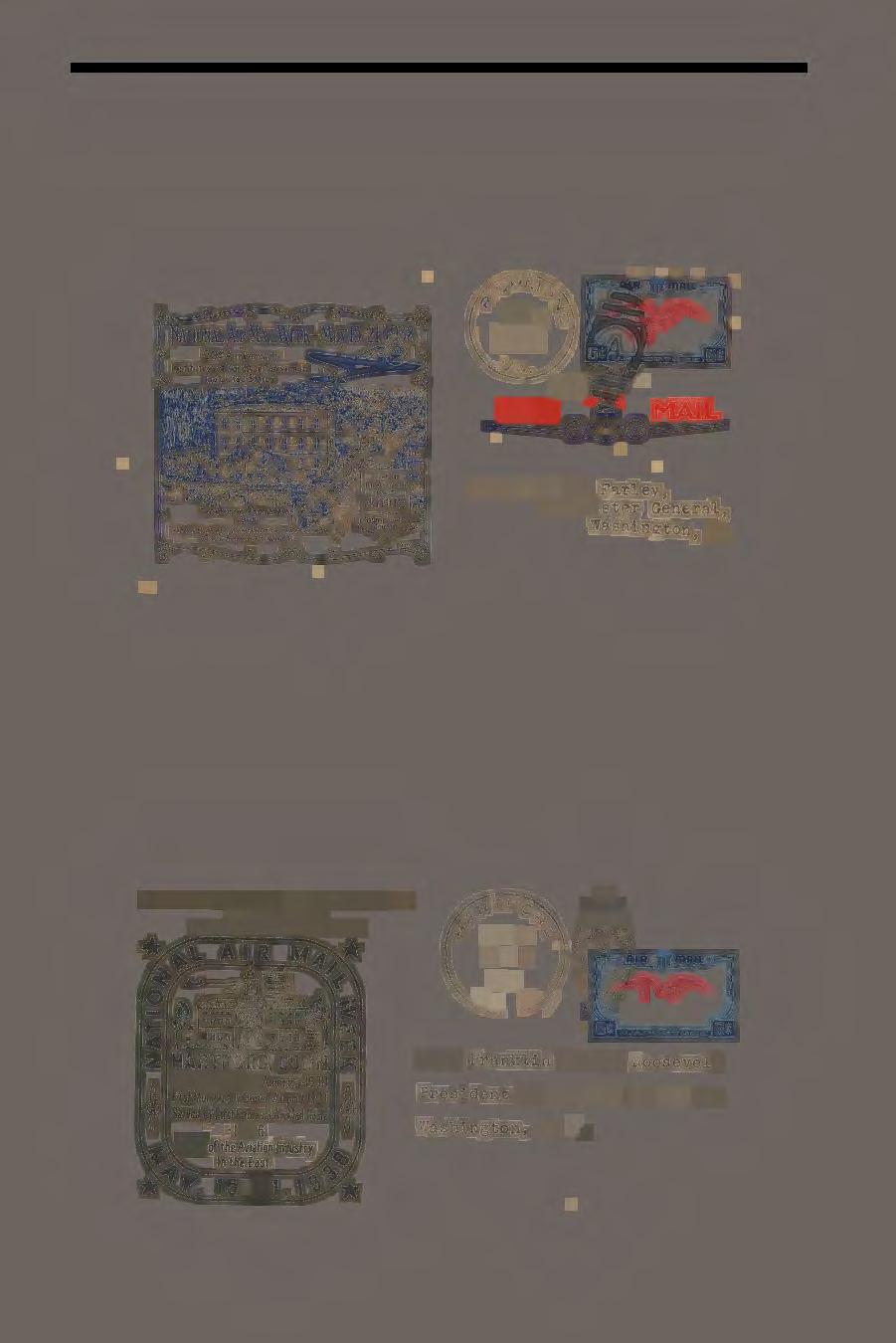
Civil War. With a modern airplane flying above this picture of devastation, the cachet proudly proclaims that “Out of the Ashes of 1865 Richmond has triumphantly arisen”.
I have an especially wide range of National Air Mail Week covers sent to FDR in my collection, including many shown in this article. That these were preserved in FDR’s personal stamp collection is shown by the presence of H.R. Harmer auction authentication handstamps on the back (or front) of each cover.
172 THE UNITED STATES SPECIALIST
Figure 3. Farley NAMW cover from Richmond, Virginia.
HARTFORD CHAMBER OF COMMERCE , INC 8 05 MA I N S TREET HARTFORD , CONNECT ICUT Hon. Jas. A. Farley, Postmaster General, Washington, D.c. ... ~- + '{ r.;ii"""'l..,,-,...,.,."'"c:aa,"" _; I Hon Franklin President o f the United btates Washing to n, D. c.
Figure 4. NAMW cover sent to FDR from Hartford, Connecticut.
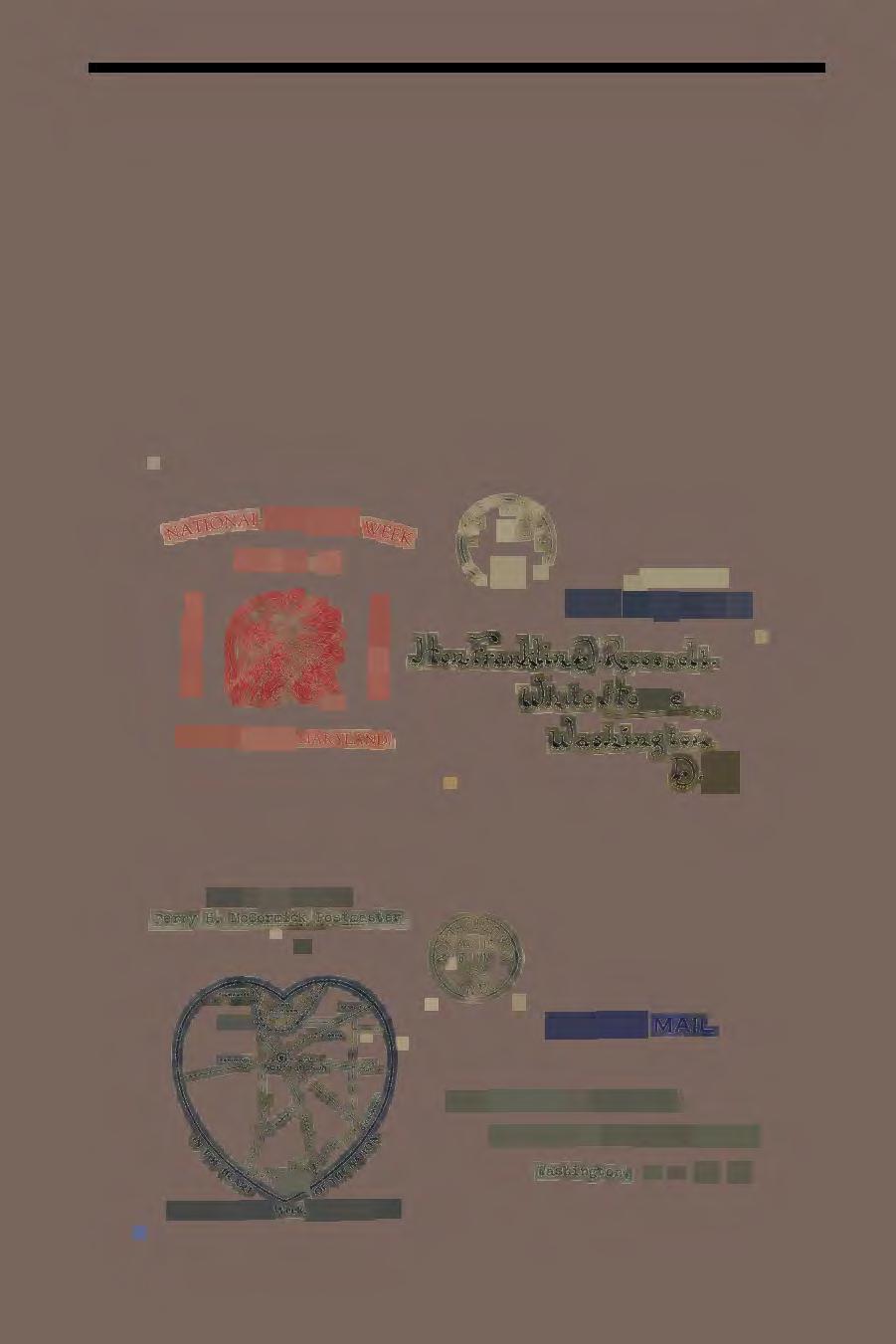
An example sent to FDR by the Chamber of Commerce of Hartford, Connecticut on Sunday May 15 is displayed in Figure 4. The cachet proclaims Hartford as being the “Home of the Aviation Industry in the East” having had the first Aero Club of America in 1908, having the first municipally owned airport in 1921, and touts that Hartford was served by the First Contract Air Mail Route in 1926. Note that the cover is franked by an upper left corner margin copy of the 6¢ bi-color airmail stamp that clearly shows the bi-colored cross used to help ensure against inverted printing of these stamps. It’s also clear that this stamp is from plate position one of the pane.
In Figure 5, is shown a May 15 NAMW cover sent to FDR by airmail from Indian Head, Maryland a mere 30 miles from Washington, DC, a distance that certainly did not require the use of airmail. Nonetheless, fancy calligraphy was used in addressing it to FDR , and there is a brightly printed Indian chief in headdress on the cachet, reflecting the name of the town.
APRIL 2024 173
Figure 5. NAMW cover sent to FDR from Indian Head, Maryland.
~p._·noNAL AIR MAIL WEE[( MAY 15 - 21 - 7 /y /4 <' - '_'{ 15' ) \ 0 1938 , • , n 1 9 1 8 1 9 3 8 VIA AIR MAIL J1~n.C~1~\~n.B-~9~~1.l~11. Wlut~ JtQYrHi _.c_--~~ INDIAN HEAD, MARYLAND. ws,~h..ia..g t.9, ~ B-~ VIA AIR MAIL
D. Ro o sevalt, FTeside.nt of the. United state.a, Washington, - - D. C.
Figure 6. NAMW cover sent to FDR from North Judson, Indiana.
Hon. Fra.nklin
Another May 15 cover sent to FDR , this time from North Judson, Indiana, is shown in Figure 6. The name of the local postmaster has been typed above, and the cachet proclaims that North Judson is “In the heart of the Nation.” A locator map in the shape of a heart is also conveniently provided.
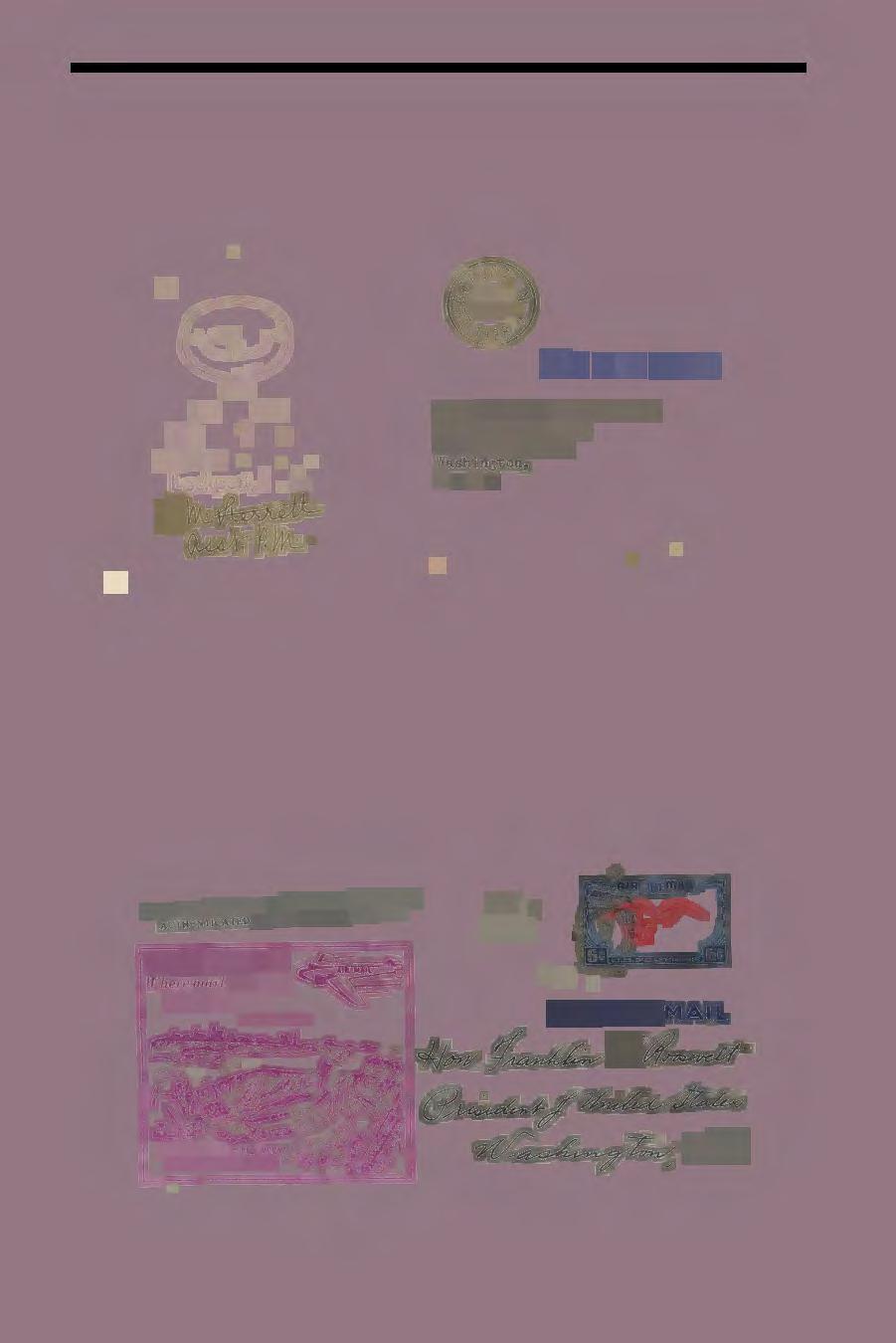
A May 16 NAMW cover sent to FDR , from Lockport, New York, and signed by the assistant postmaster is shown in Figure 7. The cachet celebrates the famous 5¢ Lockport Postmaster Provisional hand stamp of 1846, reproduced in facsimile. With only a single example known, the Lockport Provisional is one of the great rarities of US philately, and this NAMW cachet must have appealed to FDR as an avid stamp collector. Lockport itself was a key part of the Erie Canal, where its locks allowed canal barges to traverse a 60-foot natural drop in the waterway, an impressive engineering feat that was completed in 1825.
Where marl was first mined in U. S.
174 THE UNITED STATES SPECIALIST
Figure 7. NAMW cover sent to FDR from Lockport, New York.
1846 NATO>-IAL
tv\ ;I \: 1 e ~, MA115,-\;, a Lv... r., I~- •· • OOSEVELT COLLECT ION FROM THE FRANK.LIN D. It MER INC., N , y ' AU1HE~TlCATED BY H. R , HAR
President
.• The White
D • C •
Figure 8. NAMW cover sent to FDR from Marlton, New Jersey.
A·r
Hon. Franklill D. Rooeevelt
of u.s
House, Washington,
MARLTON,N.J.
VIA Al
·MAI_L ~ -~ -~-~'"~-:--:-::- - Y.;;t. ?U~ t/!
R
Unique local products were also featured on NAMW covers sent to FDR , such as the one in Figure 8 from Marlton, New Jersey. The cachet shows the mining of marl, an unconsolidated sediment of carbonate minerals, clays and silt, used as fertilizer, after which Marlton was named.
Besides local postmasters and civic organizations, private individuals also mailed NAMW covers to FDR . A May 16 example from a Mrs. Elizabeth Arnold from Lewisburg, Kentucky, is shown in Figure 9. The cachet touts a nearby “Prehistoric Lost City” consisting of earthen mounds built by Native Americans that was first excavated in 1929 and then operated as a tourist attraction for a few years after 1936.
By far the most interesting day of National Air Mail Week was Thursday, May 19, 1938. This was designated as a special day when even the smallest towns and hamlets without nearby airports might receive airmail service using special airmail flights with the help of
M£FARLAND, CALIF.
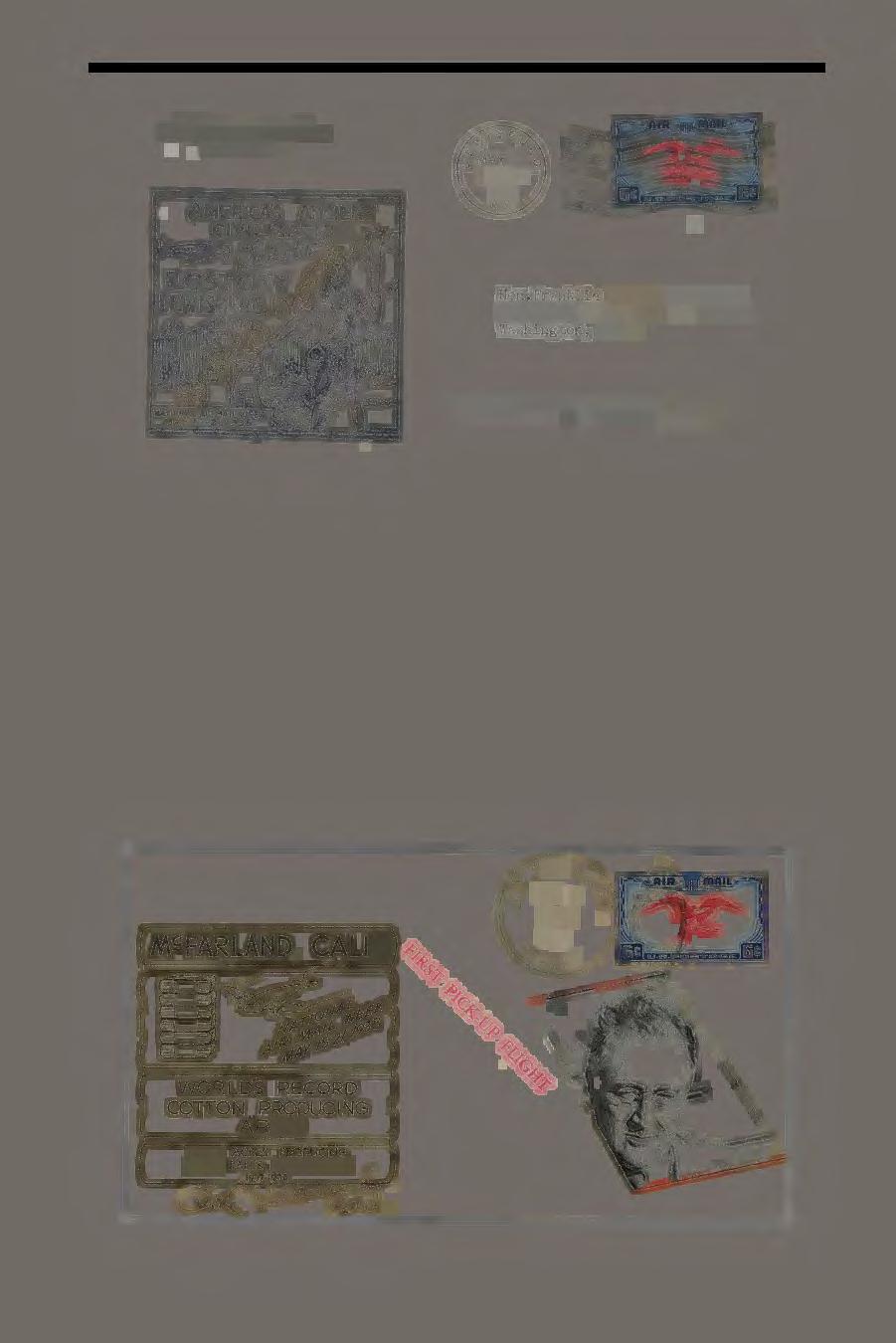
WORLDS RECORD COTTON PRODUCING AREA
APRIL 2024 175
Figure 9. NAMW cover sent to FDR from Lewisburg, Kentucky.
Figure 10. NAMW cover sent to FDR from McFarland, California addressed to FDR using a photograph.
MRS. ELIZABETH ARNOLD LEWI S BURG , KY
" ,. . I.OST~
AMERICA'S ANCENT CIVILIZAT
IT
Hon . Franklin Delano Roosevelt President of the United Stat es Washington, D. C FROM THE FRAN K LIN D. ROOSEVE L T COLLECTION AUTHE~TICAT.ED &y H. .lt. HAllMElt INC.., N. Y.
volunteer pilots and pick up points. In some cases, farmer’s fields, blocked off portions of country roads and even a pond for landing a seaplane were utilized.
Perhaps my favorite May 19 NAMW cover sent to FDR is the one from the small city of McFarland, California, shown in Figure 10. Situated in the San Joaquin Valley about 25 miles north of Bakersfield, California, the cachet touts McFarland as being the “World’s Record Cotton Producing Area” with 22,000 acres producing 26,000 bales of cotton during the 1937–38 season. The cover is handstamped “FIRST PICK-UP FLIGHT” and is signed by the postmaster who has cleverly addressed it by simply pasting on a photograph of FDR cut out from a magazine. The H.R. Harmer auction backstamp demonstrates that FDR received it without problem.
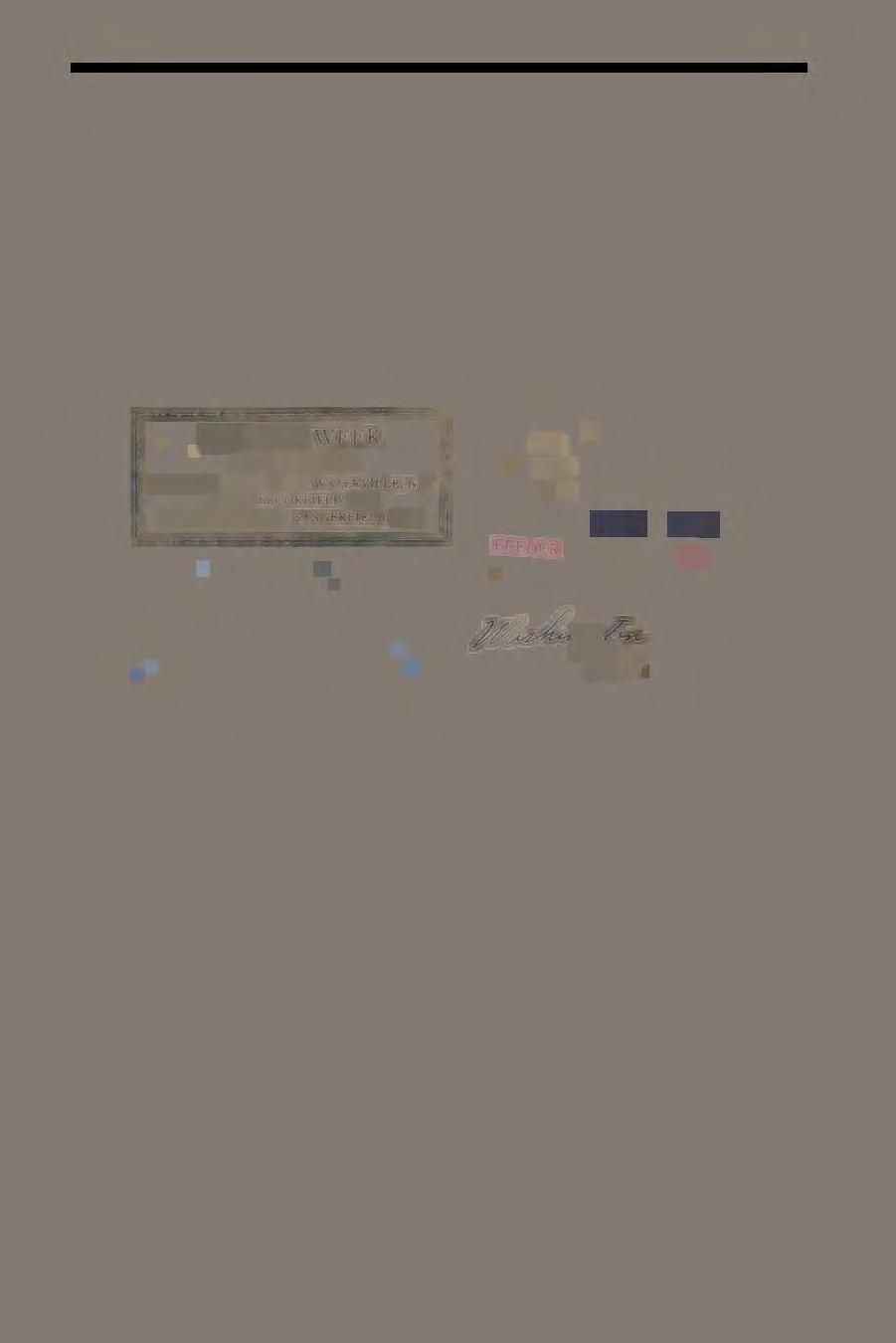
Small towns and villages often cooperated during National Air Mail Week, as shown in Figure 11 on a cover sent to FDR on May 19, 1938. The cachet lists the names of five small communities in upstate New York over a half-tone printed photograph of Oriskany Falls signed by the local postmaster. Hand addressed to President Franklin D. Roosevelt, note especially the “FEEDER SERVICE MAY 19th” handstamp above the address.
One of the more unusual May 19 NAMW covers sent to FDR is the one from Woburn, Massachusetts, shown in Figure 12. The printed cachet was sponsored by the Woburn Lodge of the Benevolent and Protective Order of Elks, touts Woburn as “Leather City,” and shows a picture of Dan Doherty, National Commander of the American Legion. Most interestingly, there is a handstamp showing that special May 19 airmail service was provided by a seaplane landing in Horn Pond!
A NAMW cover with a half-tone printed photograph that was sent to FDR is shown in Figure 13. From Catawissa, Pennsylvania, this photo shows its 1789 Quaker Meeting House. It is signed by the postmaster who has made a special notation that this was the first cover canceled. Also note that this was franked by a plate number single showing part of the arrow in the sheet margin. Analysis reveals that this 6¢ bi-color airmail stamp must therefore be from plate position two of the stamp pane.
176 THE UNITED STATES SPECIALIST
Figure 11. NAMW cover sent to FDR from Oriskany Falls, New York.

VIA AIR MAIL
HO?l, FRANXLIN D ROOSEVELT PRESIDENT U S A.
WASHINGTON , D , C ,
APRIL 2024 177
Figure 12. NAMW cover sent to FDR from Woburn, Massachusetts.
Figure 13. NAMW cover sent to FDR from Catawissa, Pennsylvania.
Figure 14. NAMW cover sent to FDR from Beatrice, Nebraska.
Another May 19 dated NAMW cachet printed on the cover is shown Figure 14. Sent to FDR from Beatrice, Nebraska, it has been signed by the postmaster and touts the very first homestead in the United States under the Civil War era Homestead Act. Interestingly, this homestead was claimed just after midnight on January 1, 1862, near Beatrice when a clerk was persuaded to open the local Land Office.
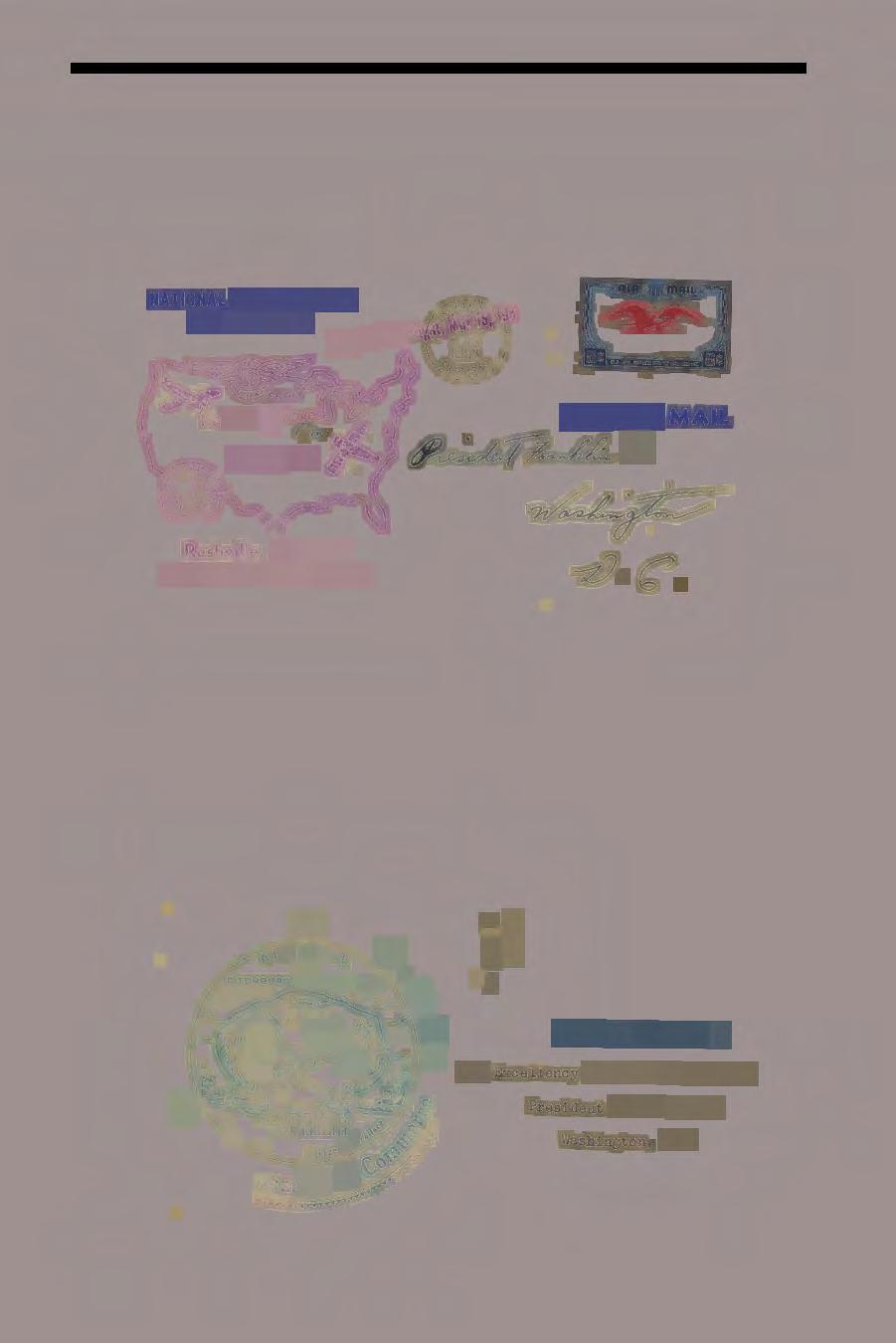
A more generic hand stamped NAMW cachet from Rushville, Nebraska, is shown in Figure 15. Sent to FDR by the local postmaster, this shows a locator map for Rushville within a large outline map of the United States. At the bottom Rushville is touted as “The Home of Old Jules.” This refers to an award winning biography Old Jules about Jules Sandoz, a Swiss immigrant and early pioneer in the area that was written by his daughter.
Among my favorite NAMW cachets with local flavor is the one on the May 19 cover sent to FDR from Fitchburg, Massachusetts. Shown in Figure 16, this features the
VIA AIR MAIL
His ExcelLency Franklin D. Rosevelt
President Ot The United St
IVasllington, n.c.
178 THE UNITED STATES SPECIALIST
Figure 16. NAMW cover sent to FDR from Fitchburg, Massachusetts.
Figure 15. NAMW cover sent to FDR from Rushville, Nebraska.
, ~..JL#.f~ -;V, 6 -
VIA AIR MAIL
Rollstone Boulder, a massive ten-foot-tall, 110-ton porphyritic granite glacial erratic, resembling a giant potato that was re-located in 1930 to a traffic island in downtown Fitchburg. Signed by the postmaster, the cachet is from the Fitchburg Chamber of Commerce, courtesy of George R. Wallace.
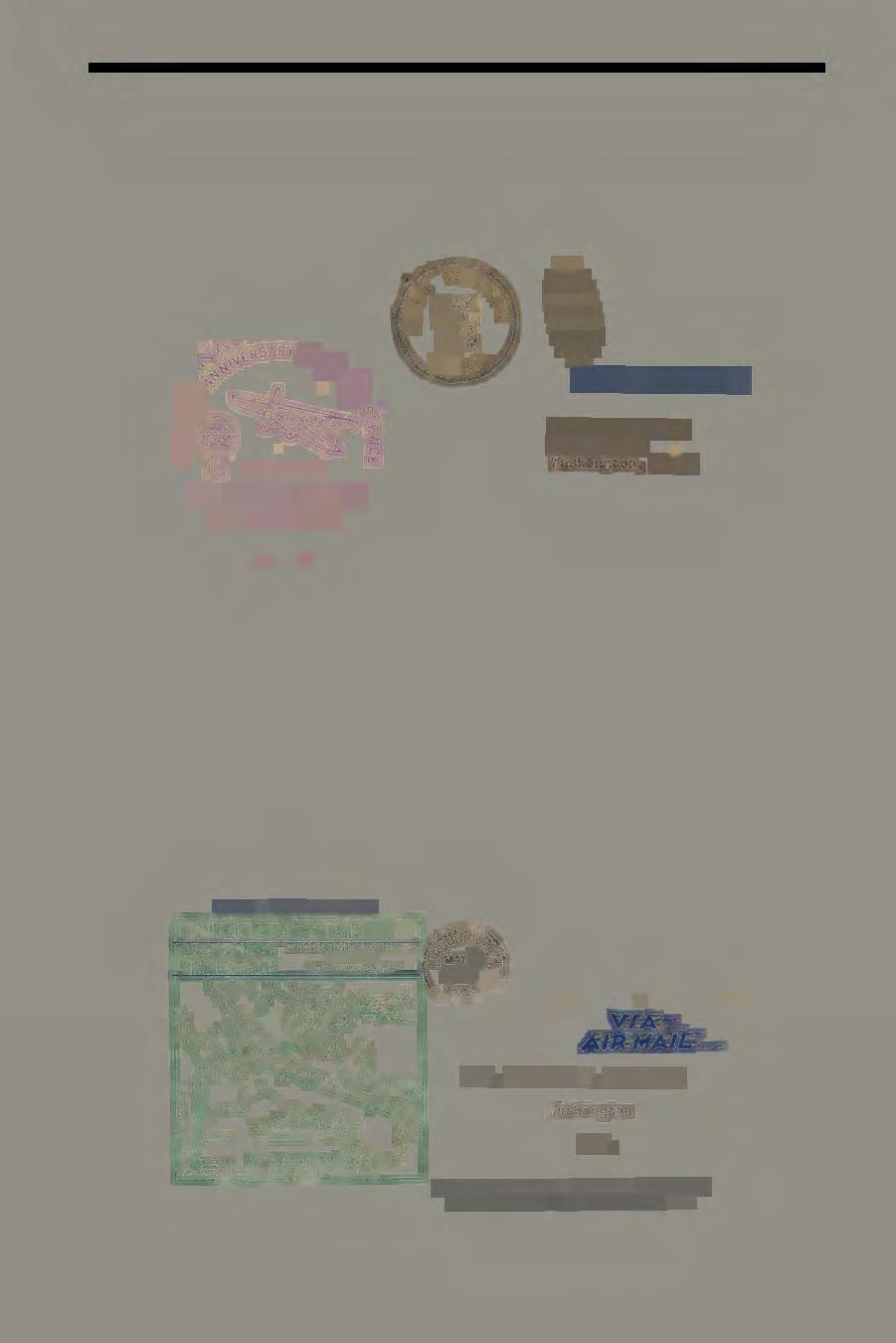
VIA AIR MAIL
Hon. Franklin D. Roosevelt Vlh1te House VTashington, D c.
Figure 17 shows another May 19 NAMW cover sent to FDR from Massachusetts. From West Warren, this has a cachet sponsored by Wm. E. Wright and Sons Co, well known manufacturers of Bias Tape used in sewing. While celebrating the twentieth anniversary of airmail service, the cachet also shows a small image their product at the left.
Shown in Figure 18 is a May 19 NAMW cover sent to FDR from Laconia, “City of the Lakes,” in New Hampshire. The detailed locator map commemorates the 1925 route of the first Aero-Marine Mail Service (via seaplane) in the United States flown by pilot Bob Fogg on Lake Winnipesaukee.
Franklin D, Roosevelt V/ashington D.C.
APRIL 2024 179
Figure 17. NAMW cover sent to FDR from West Warren, Massachusetts.
AFTER DAYS IlETURN' TO= ~ . = l!,/;ITa~~~~~ --
Figure 18. NAMW cover sent to FDR from Laconia, New Hampshire.
Industry and learning are promoted on the NAMW First Flight cover sent to FDR from Brunswick, Maine, in Figure 19. The cachet shows the Androscoggin River providing water power for industry which included lumber, ship building and textiles, with learning highlighted by Bowdoin College.
The NAMW cover shown in Figure 20 was sent to FDR from Plainview, Minnesota. Signed by the postmaster, the theme of the Plainview cachet is “The horn of plenty” and “the fertile fields of Greenwood Prairie.”
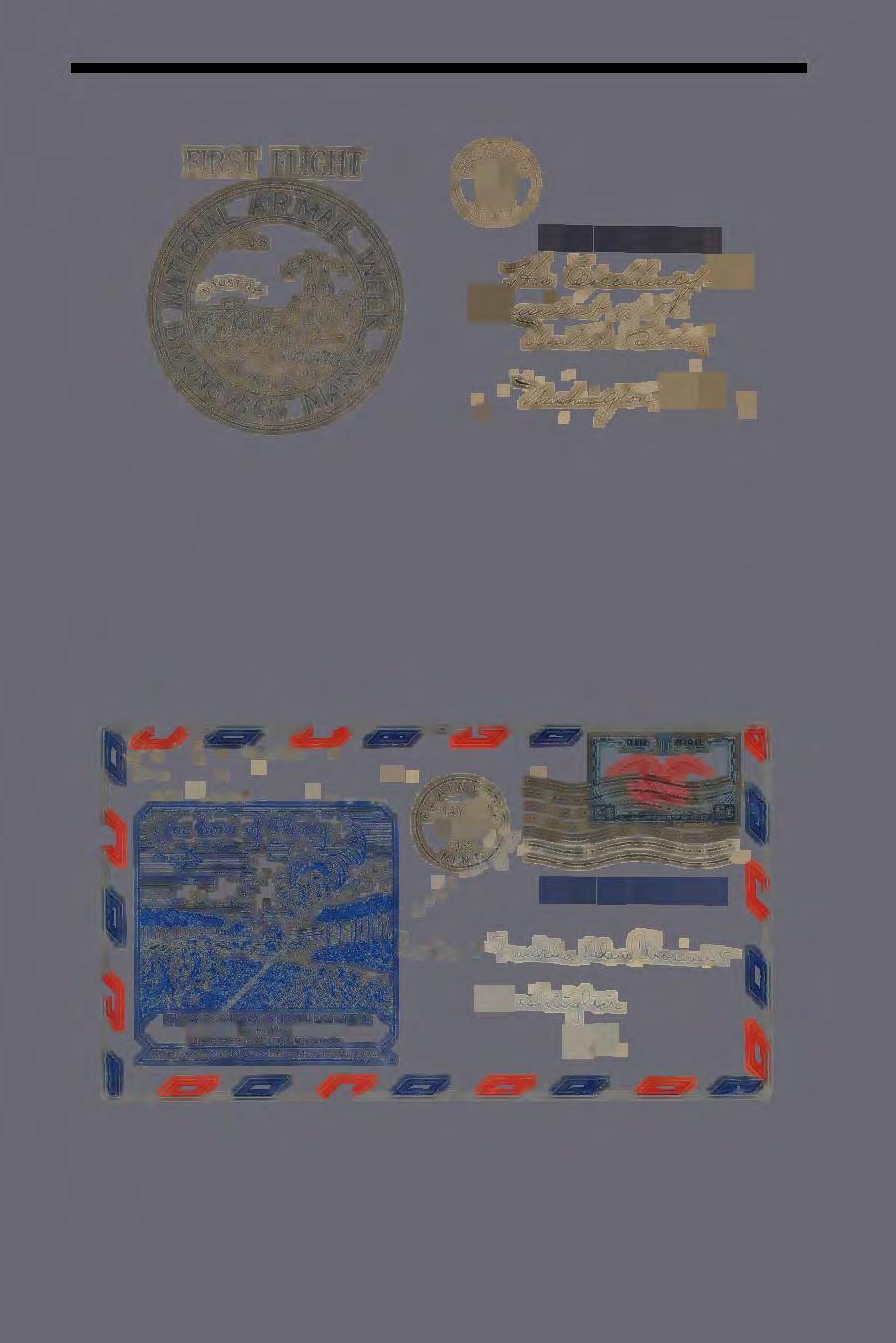
Even tiny communities participated in NAMW. Perhaps my favorite example is the one sent to FDR from Crab Orchard, a small village in Johnson County, Nebraska, shown in Figure 21. The cover uses an envelope with two-color printed cachet depicting the
180 THE UNITED STATES SPECIALIST
Figure 20. NAMW cover sent to FDR from Plainview, Minnesota.
-- ~----VIA AIR MAIL '-p~~ ~9:-6----.:.----.... VIA AIR MAIL 0 w~ ~,
Figure 19. NAMW cover sent to FDR from Brunswick, Maine.
Nebraska state capitol building in Lincoln (35 miles away) with the name Crab Orchard separately stamped below.

VIA AIR MAIL
Honorable Frank lin D. Roo sevel t P resid en t of t h e U. s . Wash i ngton , D. C.
Another May 19 NAMW cover mailed to FDR from the small town of Swink, Colorado, is shown in Figure 22. The cachet is actually from La Junta, the nearby county seat, “Where the Santa Fe Trail Divides.” The pilot of this first flight cover is listed as Leo Schuth.
A May 19 NAMW cover mailed to FDR by the secretary of the Iron River Business Men’s Association from Iron River in the upper peninsula of Michigan is shown in Figure 23. Its cachet depicting a large tree and touts Iron River as “Gateway to the Ottawa National Forest.”
APRIL 2024 181
Figure 21. NAMW cover sent to FDR from Crab Orchard, Nebraska.
Figure 22. NAMW cover sent to FDR from Swink, Colorado.
FltOM THE FftA "l:KLIN D. R OOSEVELT COLLECTION AU'IHt:NTlCATED SY H., It. HAR.MEk lNCu N. Y.

A cacheted NAMW cover from Kansas City, Kansas, sent to FDR is shown in Figure 24. Note that this shows a special flight was made from Fairfax Airport on May 19, 1938.
Figure 25 also shows a special flight cover sent to FDR , this time from Oyster Bay, New York. Oyster Bay is the historic home of the Theodore Roosevelt branch of FDR’s extended family, with the cachet depicting an airplane flying above a sailboat, superimposed over a stylized marine compass. Unusually detailed routing for this May 19 airmail cover is revealed by two machine cancellations on the back. Following the originating Oyster Bay postmark at 10:30 am, these indicate routing via Floyd Bennett Field in Brooklyn, New York, at noon and Newark, New Jersey at 4:30 pm, before going on to its final Washington, DC, destination.
182 THE UNITED STATES SPECIALIST
Figure 23. NAMW cover sent to FDR from Iron River, Michigan.
NATIONAL A I R MAIL WEEK SPECIA - L GH T M A 't \t,T H FAl l"A >, A l fl:f> ORT VIA AIR MAIL
Franldin D. Roosevfll t White House, washin~ton, n.c. FROM THE FRANKLIN D. RVOSt:V,~LT COLLF.CTluN AUTHE~TICATEO BY H R. HARMEk INC., N. Y. VIA AIR MAIL
Vlhi
C.
Figure 24. NAMW cover sent to FDR from Kansas City, Kansas.
President
His Excellency, The President The
te House Washington, D.

Early transportation by train is the theme of the cachet on the NAMW cover sent to FDR from Bordentown, New Jersey shown in Figure 26. The cachet depicts the original 1831 “John Bull” locomotive that operated in New Jersey from 1833 to 1866 and is now preserved in the Smithsonian museum. More interestingly, the cover was apparently sent to FDR by the volunteer NAMW pilot, C. J. McKenna, who both flew the airplane from Bordentown and autographed the cover. Routing was via Camden, New Jersey, as indicated by the machine cancellation on the back.
APRIL 2024 183
Figure 25. NAMW cover sent to FDR from Oyster Bay, New York.
NATIONAL f, IR MAIL WHk MAY JS .2 1, 1936 Special Flight - Oyster Bay, N. Y. to Floyd Bennett Field May 19, 1938 Bernard H. Power,, Postmaster VI A A IR M AIL ~~oP. . .______;;;.;,.,;,;;,;.;, ______, FROM THE FRANl:UN D ROOSEVELT COLLECTION
Figure 26. NAMW cover sent to FDR from Bordentown, New Jersey with autograph from pilot C. J. McKenna, who flew the cover and sent it to FDR.
VIA AIR
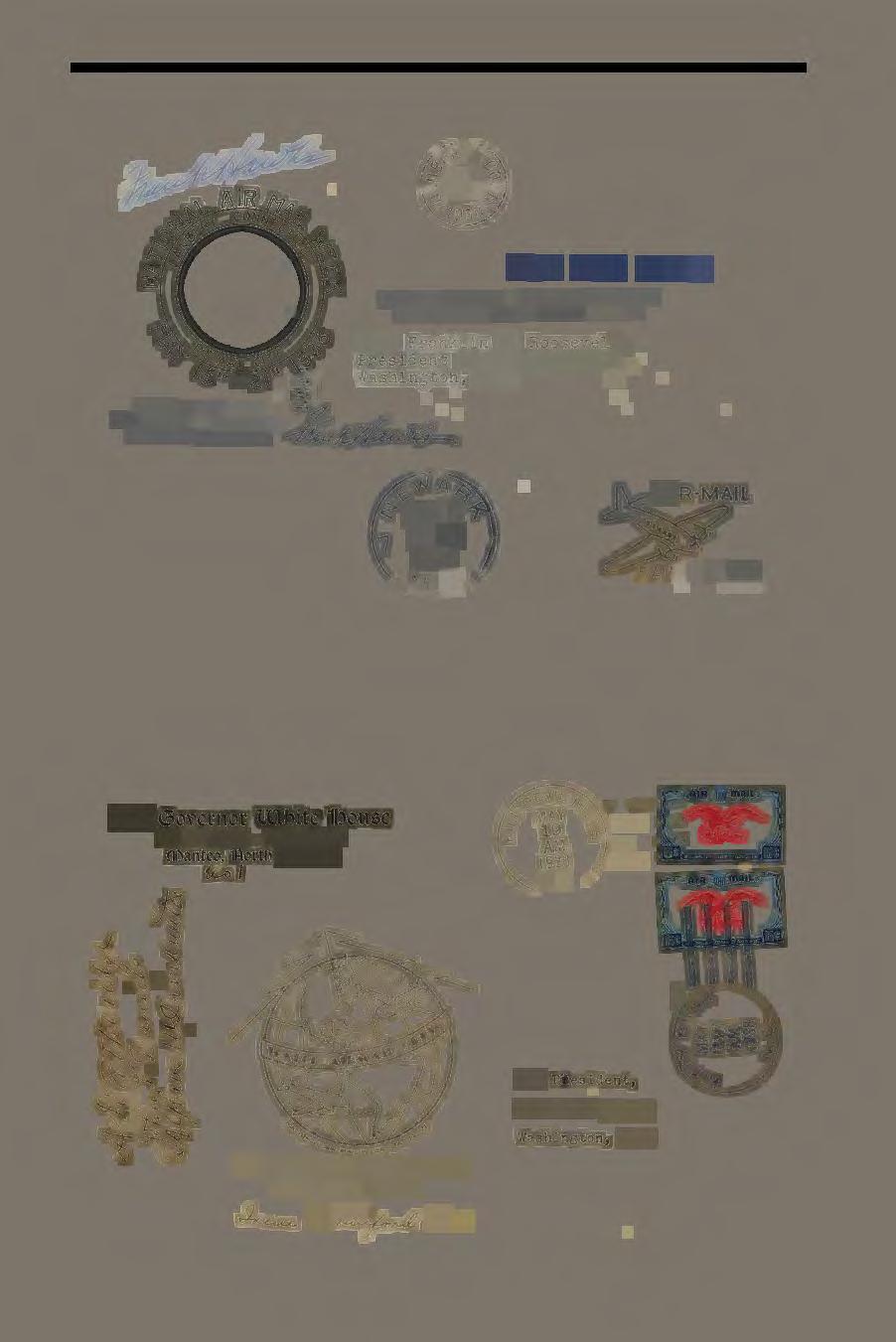
Another pilot autographed May 19 cover sent to FDR is shown in Figure 27, this time from Danbury, Connecticut, described as “Hat City” on the cachet. Note the printed signature “Frank Hawks” below the cachet, with another hand signed in blue ink above. Frank Hawks was a famous aviator known as the “fastest airman in the world” who
\!:be '1,o\'?ernor Wlbite bouse
Old Fo rt Raleigh ·~ Roanoke Island
Manteo, 'Rortb a:arollna (L.,o I
184 THE UNITED STATES SPECIALIST
Figure 28. NAMW cover sent to FDR from Kill Devil Hills, North Carolina, and signed by local dignitaries.
Figure 27. NAMW cover sent to FDR from Danbury, Connecticut and autographed by pilot Frank Hawks.
FROM THE FRANKLIN D. ROOSEVELT COLLECTlON AUlHl!~TlCATED BY H.. R.. HAJUdD. INC., N. Y.
l\ill Devil Hills. North Carolina Birthplace of Aviation" <' .,_M, (J) 38 ,,,,--· / Th e Pt es id ent , The Whi t e Hou s e, Wa shin gto n, D,C ,
had set more than 200 point-to-point speed records in the United States and Europe. Appropriately, there is machine cancellation shown on the back for Newark, New Jersey, with the slogan “Air-Mail Saves Time.” Hawks himself was killed while flying an experimental aircraft about three months after NAMW.
The oversize May 19 NAMW cover sent to FDR shown in Figure 28, commemorates the “Birthplace of Aviation” at Kill Devil Hills, North Carolina, where the Wright brothers made the first controlled, powered airplane flight on December 17, 1903. Note that the cover has been franked with two examples of the 6¢ bi-color airmail stamp, the second of which has a Kitty Hawk cancellation. This large cover has been signed by a number of local dignitaries including the postmaster. It must have arrived at the White House fairly quickly, as on the back (not shown) is a 2:30 pm Washington, DC, “Air Mail Field” machine cancellation of May 19, 1938.
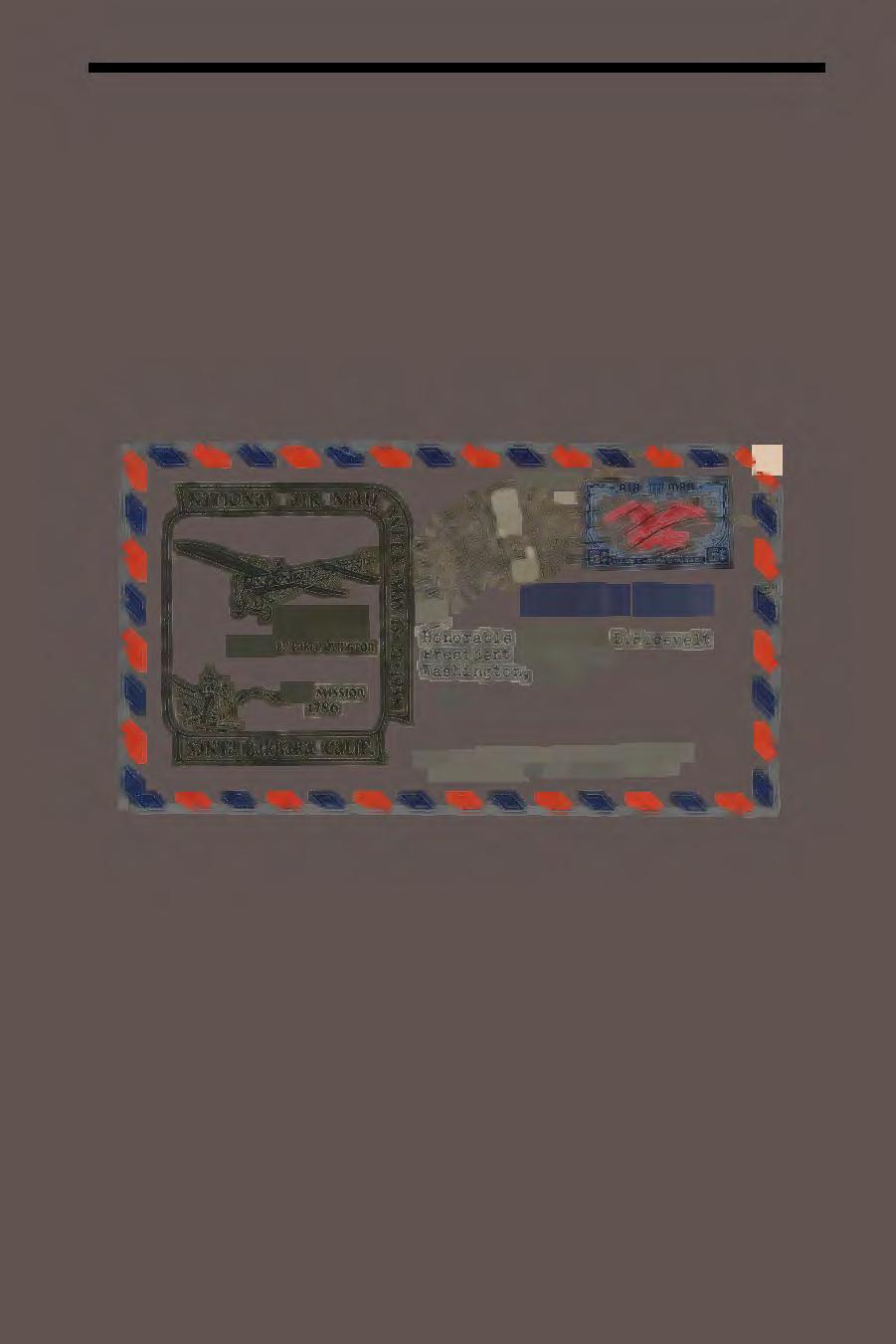
-°VIA AIR MAIL
In Figure 29, I show a May 20, 1938, NAMW cover franked with the 6¢ bi-color airmail stamp sent to FDR from my hometown, Santa Barbara, California. The cachet celebrates Earle Ovington, who in September 1911 piloted the first official airmail flight in the United States. Carrying mail from Garden City to Mineola, New York, this was flown using a French Blériot aircraft pictured on the cachet, the same type used for the first flight across the English Channel in 1909. Ovington moved to Santa Barbara in 1920 building his own landing strip, and this served as Santa Barbara’s airport until his death in 1936. The cachet also features an image of the 1786 Santa Barbara Mission, the oldest mission in continuous use in California.
It should be emphasized that not all NAMW covers were franked with the new 6¢ bi-color airmail stamp, and I show three examples of such covers from my collection sent to FDR in Figure 30. The first (without cachet) was signed by the postmaster of South Gouldsboro, Maine. Note the inverted year date slug in the cancellation. Another with cachet is from Sebasco Estates, Maine. The third, from Balwin, Kansas, is on 6¢ airmail postal stationery, this time with a cachet commemorating the Battle of Black
APRIL 2024 185
Figure 29. NAMW cover sent to FDR from Santa Barbara, California.
-saNTa
NlCLIN
ROOSEVELT
FR~~;:;;.~:i~TED BY H. R,. HARMER INC., N. y,
OLD MISSIOI\ 1786
BaRBaRa caur.
D
COLL.ECTtON

186 THE UNITED STATES SPECIALIST
NATIONAL Air Mail Week
H. St ewart; Postm>1.ster Baldwin City , Kan s a s NATIONAL AIR MAIL WEE TWE N T I ETH A NNIVERSARY 1918-1938 f '/ '-----· llffll.fCf~! t wn:r:'!!;i.., ~.Slt.i~fi,,K,llf 'r ffi Tllt'jE' ( ,!i'aftf} -"'"'~ l- .1811. < PRESIDENT F r ank li11. D hoosevelt Washington D c. Via Ai PI•esident Franklin D. Roosevelt Washing ton D C
Figure 30. Various NAMW covers sent to FDR without the 6¢ bi-color airmail stamp.
Beulah
Jack, between antislavery forces led by the abolitionist John Brown and pro-slavery forces in 1856.
Finally, things would seem incomplete without showing NAMW usage of the special delivery airmail stamp, whose vignette harks back to the first hurriedly prepared model that depicted using an eagle for 6¢ bi-color airmail stamp.1 The NAMW cover shown in Figure 31 has an advertising cachet and TWA airmail etiquette, and was mailed to FDR from the W. D. Orr Studio and Gift Shop in Memphis, Texas, on Thursday, May 19, 1938. It arrived the following day in Washington, DC, as shown by the backstamp. The advertising cachet on this cover shows an outline map of Texas revealing the location of the town of Memphis (population ~4,000 during the 1930s) in the Texas panhandle. The ad itself touts “5 hour Kodak service” for black and white film, something that seems quaint today when instant color photography by cell phone is commonplace.
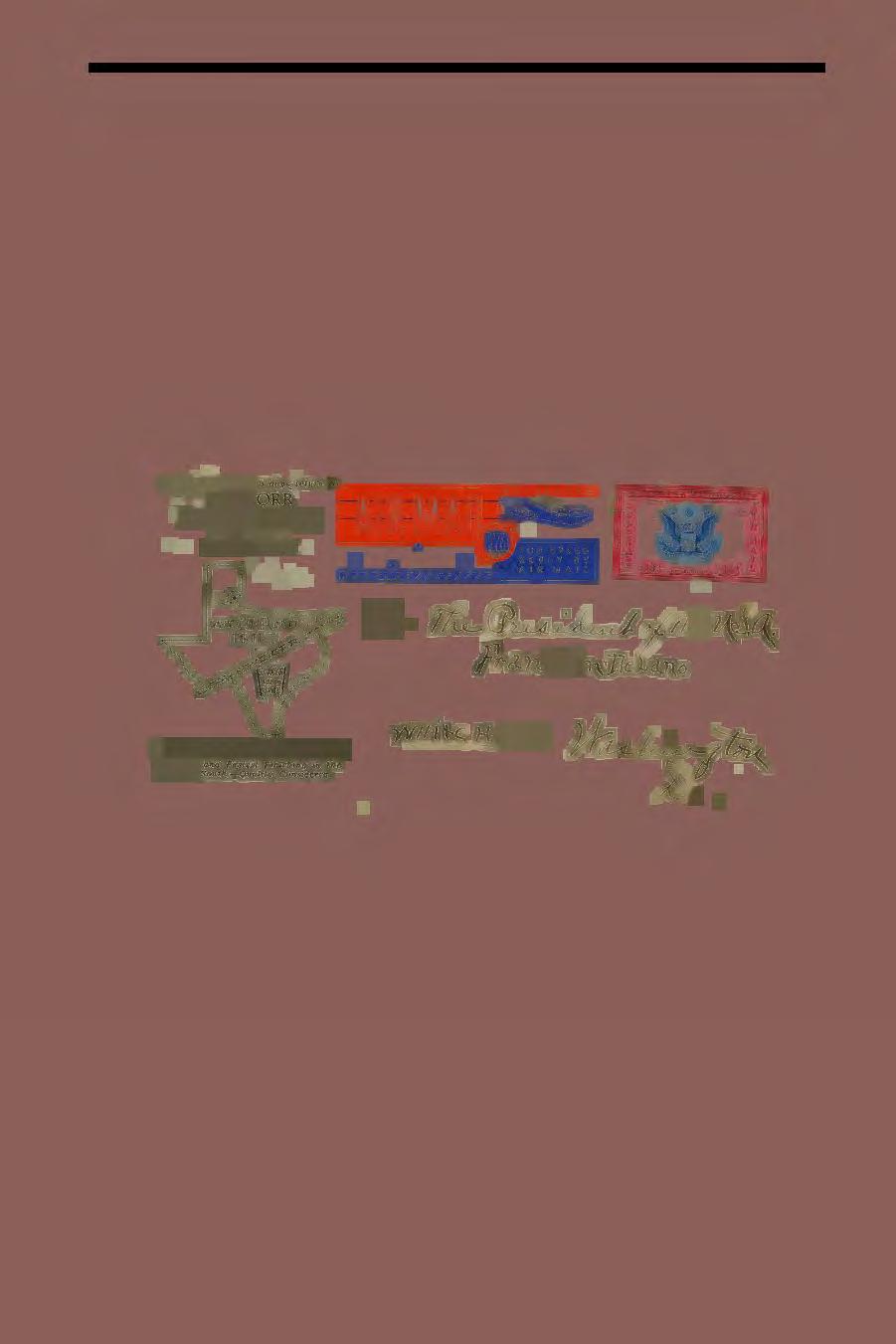
Together, the wide variety of locally produced and inspired cachet artwork used for National Air Mail Week offers collectors an intriguing range of authentic Americana, and provides highlights of what many cities and small towns believed made them special and interesting. In this article I’ve shown representative examples of these fascinating mementos that were addressed to President Franklin D. Roosevelt and his Postmaster General James A. Farley. Thousands more exist.
For example, in the collection of the National Postal Museum in Washington, there are 35 binders of National Air Mail Week material donated by PMG Farley. To give some idea of the breadth and scope of this collection, the listings include 69 NAMW covers from Alabama, 41 from Arkansas, 434 from California, 63 from Colorado, 143 from Connecticut, 33 from Delaware, 86 from Florida, 84 from Georgia, etc., totaling more than 6,100 from around the United States.
Auction catalogs from the 1946 H.R. Harmer auction of the Franklin D. Roosevelt stamp collection show more than 4,100 NAMW covers addressed to FDR ,2 mostly from
APRIL 2024 187
5 HOUR KODAK SERVICE C h eape$t and F a1test Finish i ng in th..c Enti r e South,--Quiilit11 Consi d ered. Do- ?fu__~~~ b{J~ Fr-t1.nKJ...11-\1Jefa..no ~ oSeJ/e~t.
Figure 31. Special delivery airmail advertising cover sent to FDR during NAMW from Memphis, Texas, on May 19, 1938.
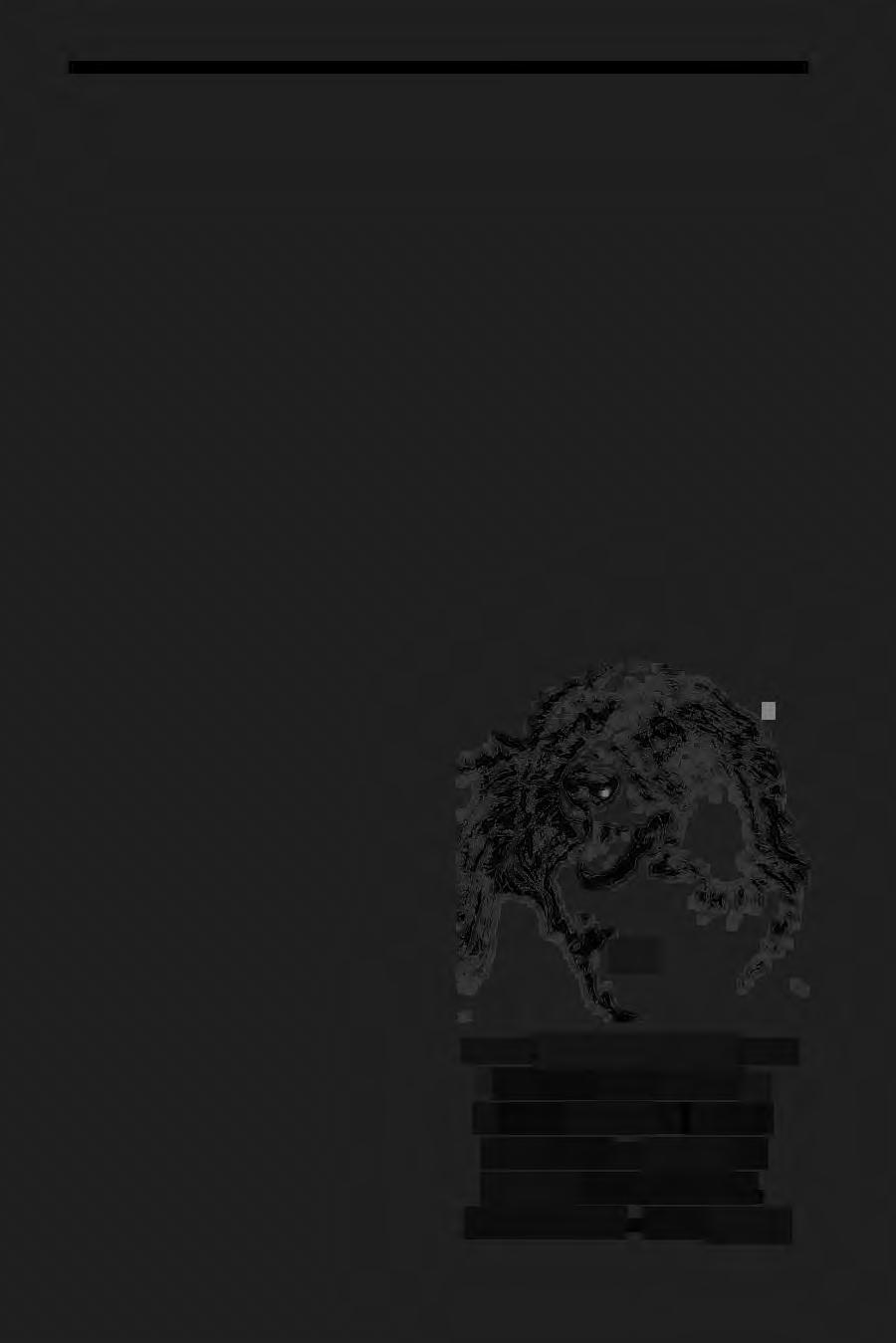
the July and December sales. These are typically grouped into large lots of up to 200 covers “addressed to the President” with NAMW cachets. Some smaller lots are described as having NAMW covers also signed by the local postmaster and/or the pilot. There are even a few lots of covers that were sent to FDR without cachets, some of these described as being signed by the postmaster. Of the overall totals listed from the FDR collection, about 17% are signed by the postmaster and about 1.7% by the NAMW pilot.
Although NAMW covers are widely available and inexpensive, determining the actual number of communities that participated in NAMW based on post office cancellations and the total number of different NAMW cachets that were produced based on distinct design types presents a philatelic research challenge. For this, the Smithsonian’s collection of some 7,350 National Air Mail Week items donated by Postmaster General James A. Farley, including over 6,100 NAMW covers, should provide a good starting point.
References
1. Paul M. Holland, “1938 Bi-Color Airmail Stamp: FDR , Farley and National Air Mail Week, Part I,” The United States Specialist, March 2024, pages 115–126 (see Figure 2).
2. The President Franklin D. Roosevelt Collection: H.R. Harmer, Inc., New York, Parts One through Four: February, April, July and December 1946.
Quality United States Stamps (1847-1945)
Singles (mint and used)
Plate Blocks
Booklet Panes plus Complete Booklets
Price lists-$2.00 each category
Price lists free on web: www.mountainsidestampsandcoins.com
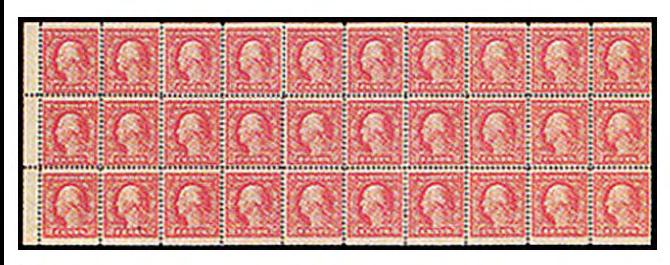
We also buy quality U.S. and foreign stamps
Mountainside Stamps, Coins and Currency
P. O. Box 1116
Mountainside, NJ 07092
Tel: 908-232-0539 or 908-419-9751
E-mail: tjacks@verizon.net
Tom Jacks, owner
Member APS, ASDA, USSS
188 THE UNITED STATES SPECIALIST
www.barneysstamps.com 19th and 20th Century United States Mint and Used with a variety of grades and condition. Fresh Stock - Visit Today
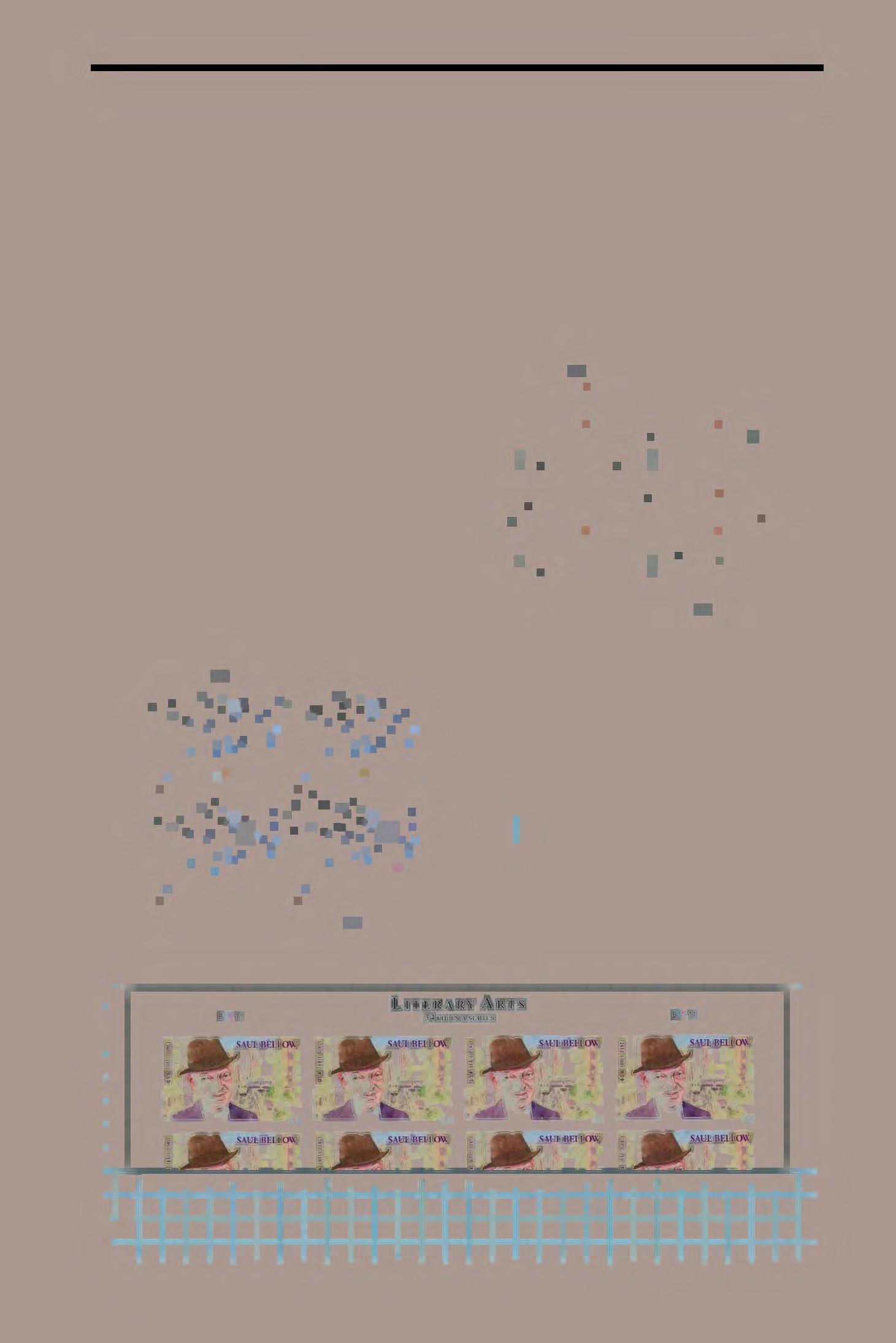
APRIL 2024 189
by Kim D. Johnson USSS #7335 | m westhome1@aol.com Plate Number Report – not pictured –#5756 (5¢) Patriotic Block Coil B222 #5827 $9.85 Pillars of Creation P1111 UL ‡ ‡ LR 1r x 6c 1,2,3,4,5,6* #5828 $30.45 Cosmic Cliffs P1111 UL ‡ ‡ LR 1r x 6c 1,2,3,4,5,6* 3 3
B11111 UL UR LL LR 2r x 3c 1,2,3,4,5,6* 3 r+-----t--------~ LIT E RARY ARTS B11 11 34TII INA SC RIES B11 11
compiled
#???? Saul Bellow
COORDINATORS: Members are invited to report their findings to the appropriate coordinator.

This monthly report is used to update the Durland Standard Plate Number Catalog.
190 THE UNITED STATES SPECIALIST
All issues through 1980 Kim D. Johnson 310 E N 3rd Street Georgetown, IL 61846
Sheet stamps after 1980 Jim Cochrane P.O. Box 2009 Great Bend, KS 67530
Coil stamps after 1980 Jill Ambrose PO Box 54622 Cincinati, OH 45254
Booklet stamps after 1980 Michael O. Perry P.O. Box 1194 Rainier, OR 97048
(10¢)
Coil B111 #???? John Wooden B11111 UL UR LL LR 3r x 3c 1,2,3,4,5,6,7,8,9* 3 3 #REA79c 50¢ Beer Stamp 18637 3 B11 1 B11 1 -1- + -1- + + -+I t -+-+ t
#????
Radiant Star
Report of the Executive Secretary
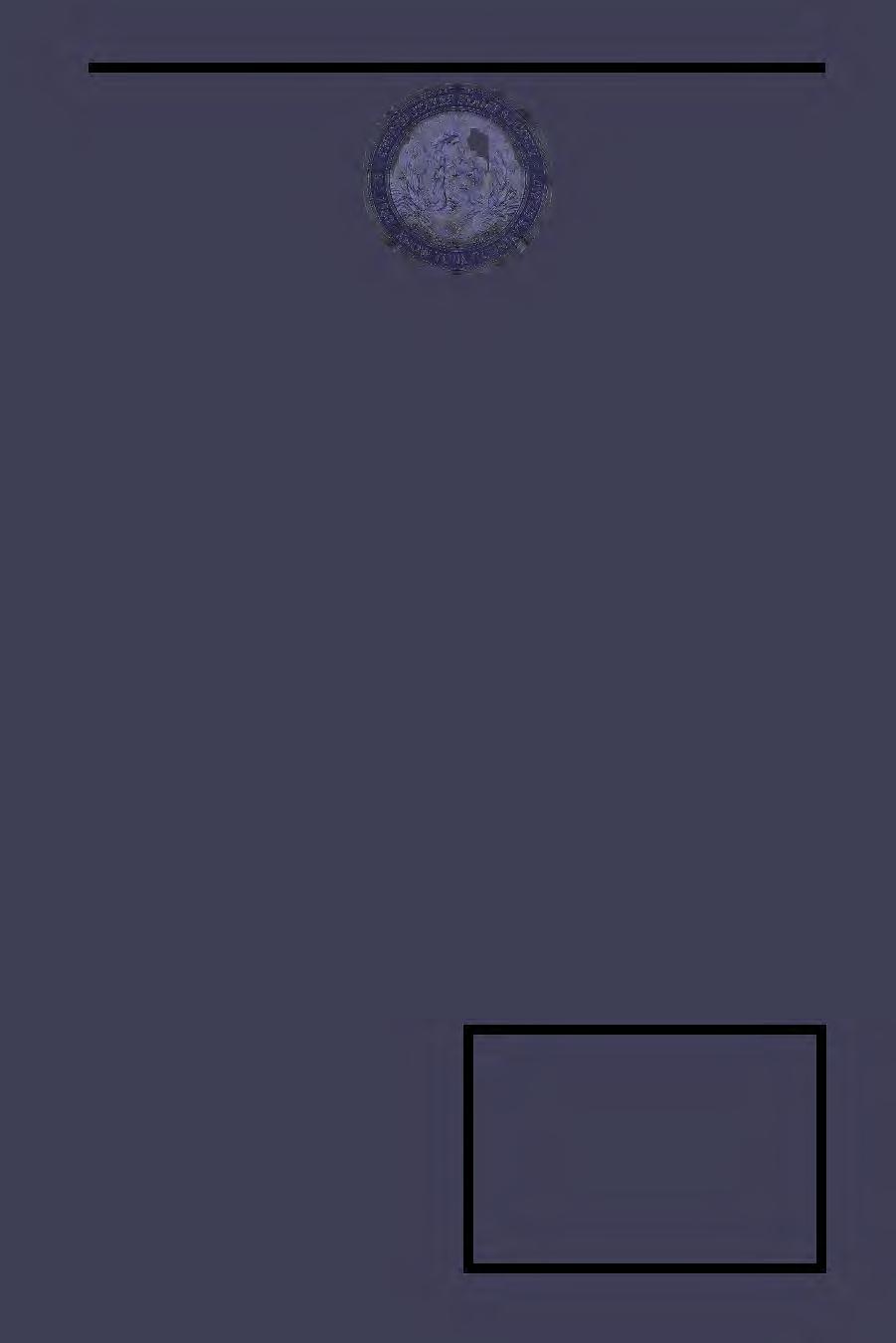
(received outside of annual dues cycle)
Joel Cohen
Rob Loeffler
Bernard Wojnowski
Richard Zane
Reinstatement?
Every year some members, unintentionally, forget to renew their membership. No problem! If you did not intend to drop your membership, reinstatement is easy—online at: usstamps.org/renew or send $25 to USSS, PO Box 1602, Hockessin, DE 19707-5602.
APRIL 2024 191
APPLICATIONS RECEIVED FOR FEBRUARY 2024 17536 Michael Hassien, Sykesville, MD 17537 Michael Boush, Austin, TX 17538 Michael Peich, West Chester, PA 17539 Richard Yarnold, Portland, ME 17540 Sharon McDonald, Quincy, MA APPLICATIONS PENDING 17527–17534 NEW MEMBERS 17518–17526 REINSTATED 11024 George Young 16493 Donald F. Dreisbach 16777 Gary Rauch 17029 Brian Selkow 17123 Mark Swan 17140 Steven Roth 17362 Chuck Courville 17416 Don Pauley DECEASED 11222 Wallace A. Craig TOTAL MEMBERSHIP January 31, 2024 1338 ADDITIONS: New members 9 Reinstated 8 Total + 17 SUBTRACTIONS: Deceased 1 Total - 1 NET CHANGE + 16 TOTAL MEMBERSHIP February 29, 2024 1354
DONATIONS

Classified Advertising ABOUT CLASSIFIED ADVERTISING
USSS MEMBERS are entitled to two free ads of up to 40 words each year. Other ads are 10 cents a word, payable in advance. For six insertions, take a 5 percent discount; for 12 insertions, take a 10 percent discount. Ads with [1130] at the end expire with this issue. Make checks payable to USSS. Send copy and check to The United States Specialist, 9038 E. 25 th Dr., Denver CO 80238. Free member ads can be emailed to: editor@usstamps.org .
WANTED
BUYING IMPERF FARLEYS WITH GUM. All offers welcome! Frank P Geiger Senior - APS Life since 1968 and ASDA since 1974. Phone: 787689-6879 – FrankPGeigerSr@gmail.com – PO Box 3442 – Pinehurst, NC 28374. [1138]
WANTED – PAYING TOP DOLLAR FOR C-13, C-14 and C-15 singles, both mint/used. Also interested in multiples, flight covers, Zeppelinrelated posters, advertisements, etc. Graf Zeppelin specialist. Rob Lehmann email: diecasttoys@ yahoo.com or call: 240-422-0118. [1150]
SPECIAL DELIVERY E15 USES WITH $2.00 & $5.00 stamps on cover or tag. No Zep uses! Send info & price to specialdelivery351@yahoo. com [1130]
WANTED: COMMERCIAL COVERS WITH US 2893 (5¢) G coil affixed. Also, commercial usages of U092 39¢ official envelope, U093 41¢ official envelope, and U094 42¢ official envelope. Rob Washburn, P.O. Box 840, Skowhegan, ME 04976. Email: stamps@ beeline-online.net [1130]
WANTED: COVERS WITH PERIOD USE OF US #1279 Albert Gallatin. Please email images and prices to ecjensen52@gmail.com. [1130]
WANTED: SCOTT 532 ON COVER without private perforations. Also other offset Washington-Franklin head material (Scott 525536). Andrew Kelley, stamps@andrewkelley. net. [1130]
S EEKING: IWO JIMA (#1929) GREEN die proof.wnkelly@earthlink.net. 3016 Jodi Lane, Palm Harbor, FL 34684. [1131]
WANTED TO BUY: I WILL PAY $60 FOR a copy of the USSS book “The United States Fourth Bureau Issues 1922-1938”. MOPerry@ mac.com Michael Perry; Post Office Box 1194; Rainier, OR 97048. Write first please. [1131]
The U.S. Philatelic Classics Society is a notfor-profit collector organization exclusively devoted to 19th century United States stamps and postal history. Our quarterly Chronicle is widely recognized for presenting new scholarship and discoveries. For membership information and much more, find us at: www.uspcs.org.
Index of Advertisers
192 THE UNITED STATES SPECIALIST
Precancel Stamp Society Interested in Learning More about Precancels? Request a copy of “Th e ABCs of Precancel Collecting” and also receive a sample copy of the PSS Forum, the Precancel Stamp Society’s monthly journal. Contact: Frank Bird III, 1095 Pinellas Point Dr South, Apt 352, St. Petersburg, FL 33705-6377. Email: promo@precancels.com. American Plate Number Single Society (www.apnss.org) ....................................................16 6 Barney’s Stamps (www.barneysstamps.com) ................................. 188 Boston 2026 World Stamp Show, Inc. (www.Boston2026.com) 167 Great American Stamp Show (www.stamps.org/GASS) .................................... 157 Alan Hovsepian (www.USatFACE.com) 156 Mountainside Stamps, Coins and Currency (www.mountainsidestampsandcoins.com) ....... 188 Precancel Stamp Society (www.precancels.com)......................................... 192 Robert A. Siegel Auction Galleries (www.siegelauctions.com) 150 Scott A. Shaulis (www.shaulisstamps.com) ................................... 151 Terry Kurzinski 151 U.S. Philatelic Classics Society (www.uspcs.org) .................................................... 192 United States Stamp Society (www.usstamps.org).............................. 152, Covers
United States Possessions: Postage Due Stamps and Covers presents the story of Postage
Due stamps used in the major possessions or territories of the United States. Written from a stamp collector’s perspective, the authors address the challenge of identifying the myriad of Possession Postage Due stamps by concentrating on stamp identification while also covering the Postage Due issues of Cuba, the Danish West Indies, Puerto Rico, the Panama Canal Zone, the Philippines and more.
In addition to the text, the monograph contains over 300 illustrations and five appendices which provide information to supplement and further explain key points. In many cases, the information presented is new or, if previously reported, organized in a new manner to help the reader understand the complexity of the Possession Postage Dues.
United States Possessions: Postage Due Stamps and Covers
Hard cover, 352 pages, 6-in x 9-in.
Member Price: $39 U.S. postpaid

Non-Member Price: $43 U.S. postpaid
Purchased online at: www.usstamps.org/store/ or by mail to: Executive Secretary, P.O. Box 1602, Hockessin, DE 19707-5602

Online at: www.usstamps.org/store 2020 Edition of the Durland Standard Plate Number Catalog 448 pages available in Perfect Bound or Spiral Bound format. Member Price: $26 U.S. plus shipping Non-Member Price: $30 U.S. plus shipping The 2020 edition the Durland Standard Plate Number Catalog provides the most comprehensive research source for plate number information on United States postage and revenue stamps, including tax-paid revenue stamps, with listings for overprinted Possessions postage, Allied Military government stamps and other back-of-the-book stamps, dummy and test stamps, MDI "Blue Cover" booklets and partial plate numbers on booklet and coil stamps.
UNITED STATES STAMP SOCIETY P.O. BOX 1602 HOCKESSIN, DE 19707-5602 04-2024 United States
Society 2020 Durland Standard Plate Number
Stamp
Catalog Order






 Andrew S. Kelley
Andrew S. Kelley


















































